

Class COLLEMBOLA Lubbock, 1870
Globular Springtails
Many pictures.
You can go along the species, but you can also make a choice from the: overview
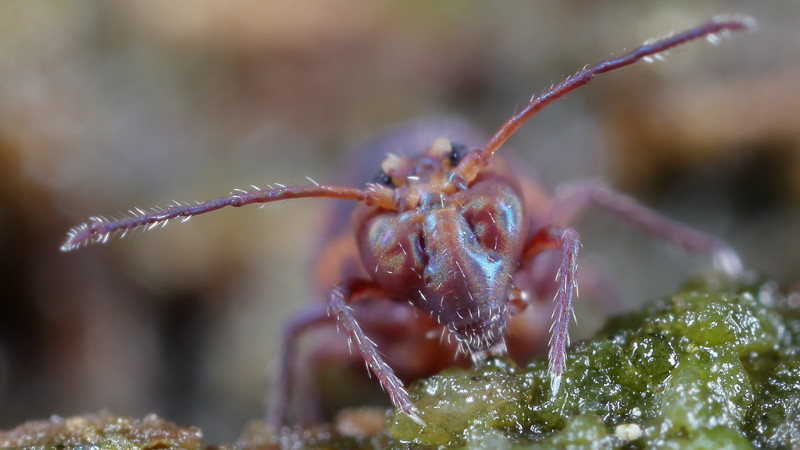
Dicyrtoma fusca
Megalothorax minimus Willem, 1900. Moderately common, widespread.
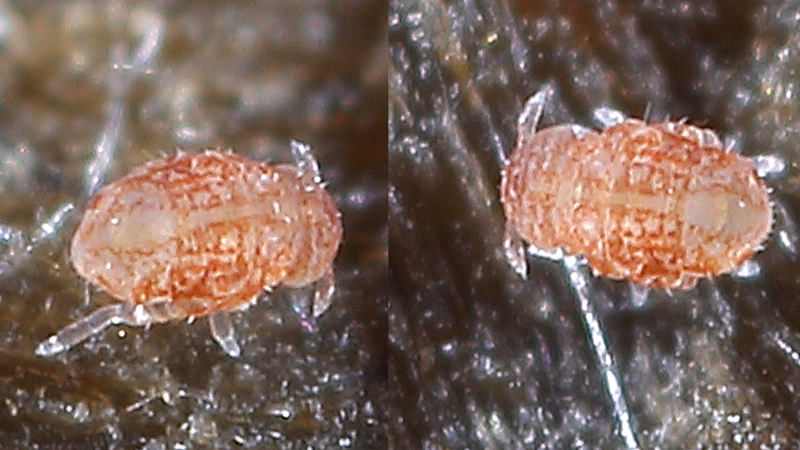
Megalothorax minimus

Megalothorax minimus, juvenile
Megalothorax minimus is about 0.25 mm. Because the animal is so small and therefore very small on the photographs, I made a collage of the pictures. On the top the adult animal underneath a young specimen. Clearly the intestinal contents is visible, indicating a not yet adult animal. Despite the size of the animal, you can immediately see that it must be a springtail. This species of springtail is not in the possession of eyes.
Pygmarrhopalites bifidus (Stach, J, 1945)
These animals have no eyes, there are only small red spots. Normally the animals live in caves. During one of our searches Peter Wieringa finds this animal on a piece of rotting wood in a forest near Ommen. The species name is not entirely certain, so subject to change.

Pygmarrhopalites bifidus
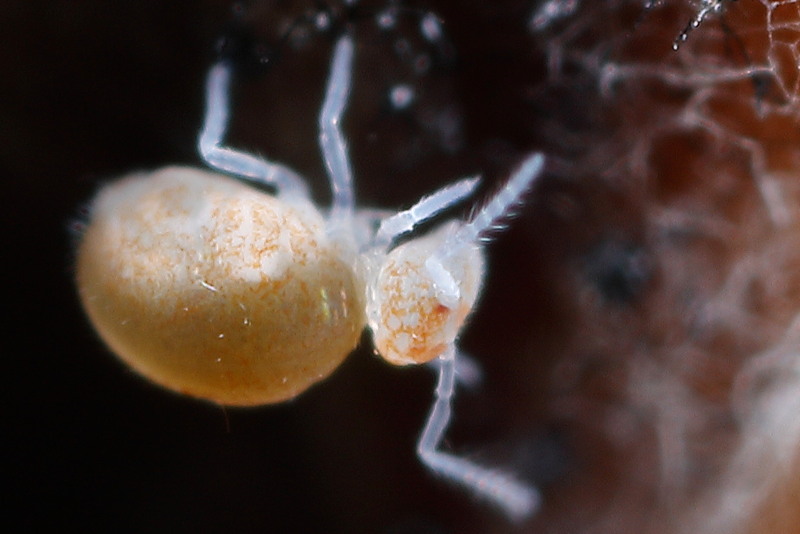
Pygmarrhopalites bifidus
Bourletiella arvalis (Fitch, 1863)
There are three species of Bourletiella in The Netherlands which are quite similar. Bourletiella arvalis yellow with 3 dark dots on the side. Bourletiella hortensis dark with pale "S" shape on the side. Bourletiella viridescens greenish with pale "S" shape + dots on the side.
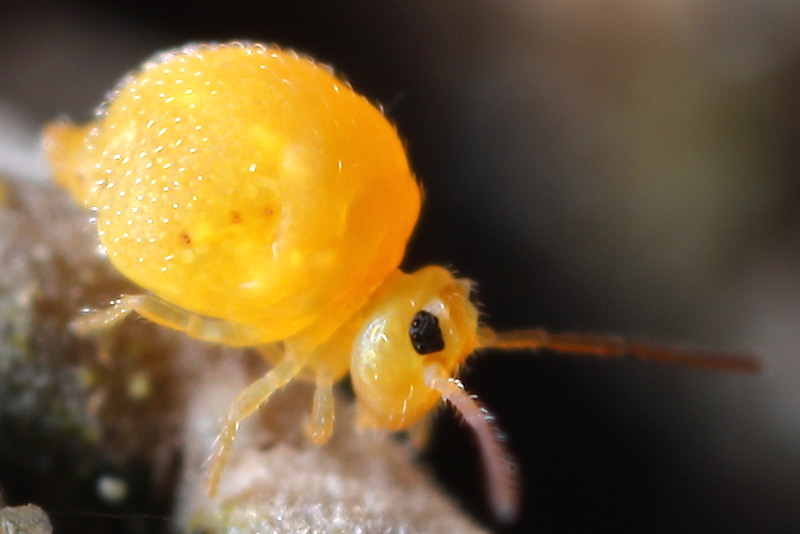
Bourletiella arvalis

Bourletiella arvalis
Bourletiella hortensis (Fitch, 1863)
Bourletiella hortensis is a very dark colored springtail with many short hairs. The short hairs are a characteristic for this whole family. The head is between the eyes red-brown, the animal has a virtually equal color only a paler "S" on the side of the body.

Bourletiella hortensis
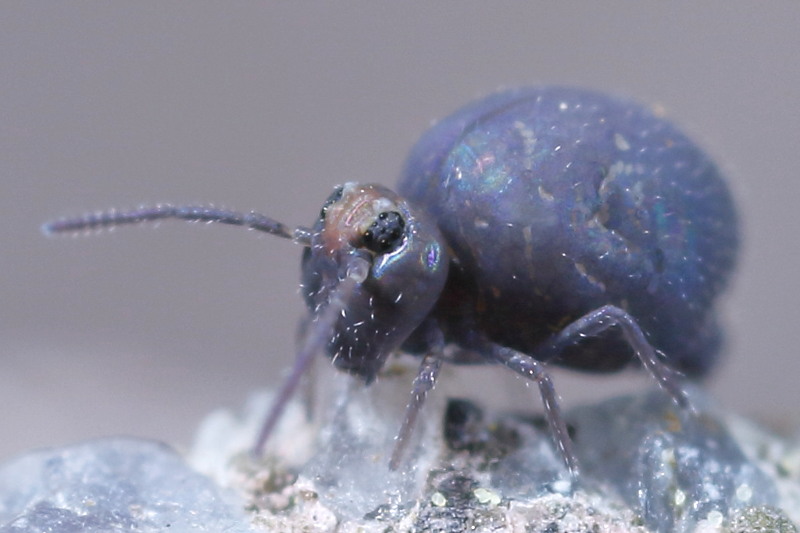
Bourletiella hortensis
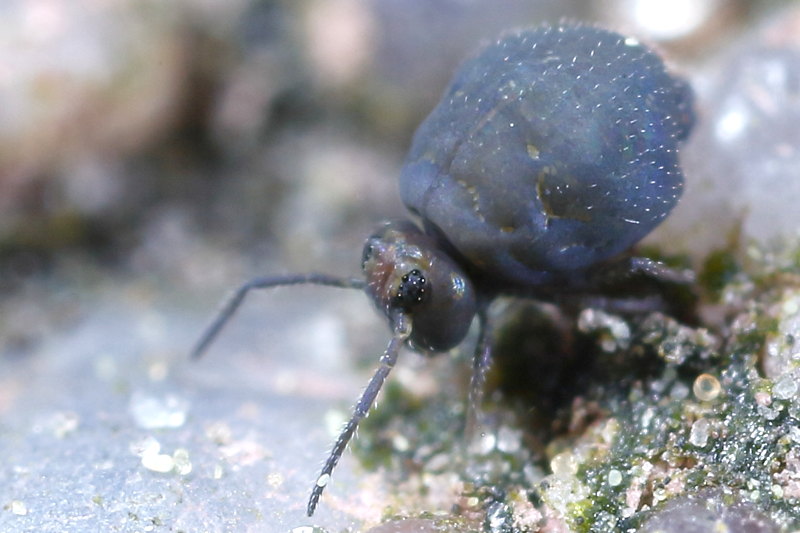
Bourletiella hortensis
Bourletiella viridescens Stach, 1920
Bourletiella viridescens is not always green as you would expect with this name. Animals I've found of this species are yellow with grey spots on the body and on the head, the antennas are also dark. They have three dark spots and a lighter "S" on the side of the body.
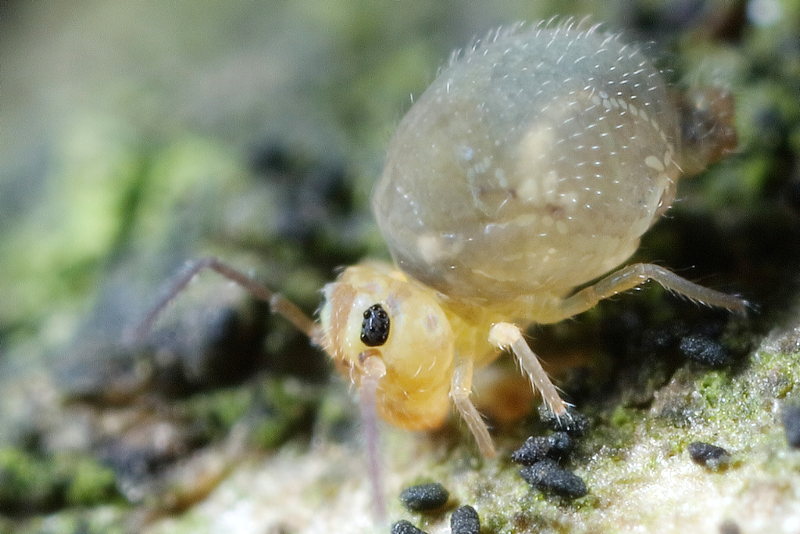
Bourletiella viridescens
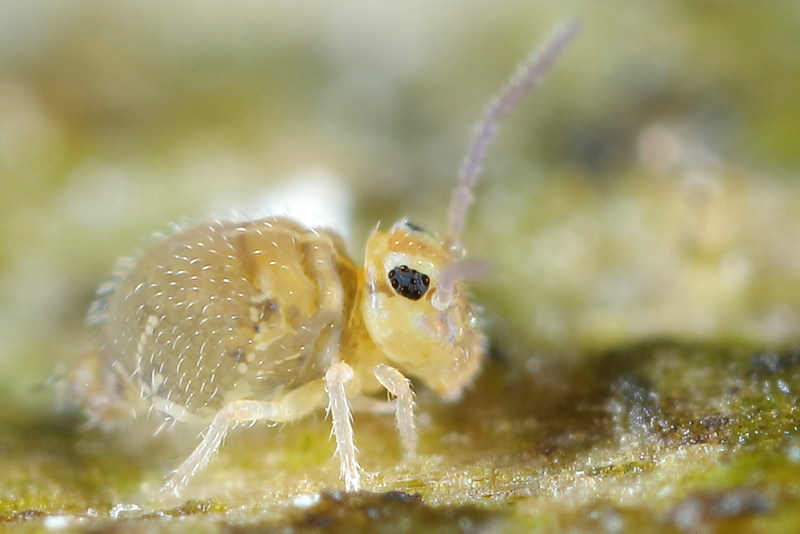
Bourletiella viridescens, juvenile
Cassagnaudiella pruinosa (Tullberg, 1871)
On the Kootwijkerzand on the Veluwe sits atop of a small dead branch a very small springtail,
less than 1 mm long. It turns out to be a male Cassagnaudiella pruinosa,
(thanks to Frans Janssens).
It is found in Scandinavia, Germany and Portugal, in The Netherlands it was last seen in 1975.
The area where I have found it is an area with sand dunes with a thin vegetation of grasses.
Between that grass was the small piece of branch where it sat on top.
This species has a lot more drawing on the body than the two previous types which are pretty smooth colored.
Later, I also find one on a sparsely vegetated area behind the dunes at Meijendel.

Cassagnaudiella pruinosa ♂
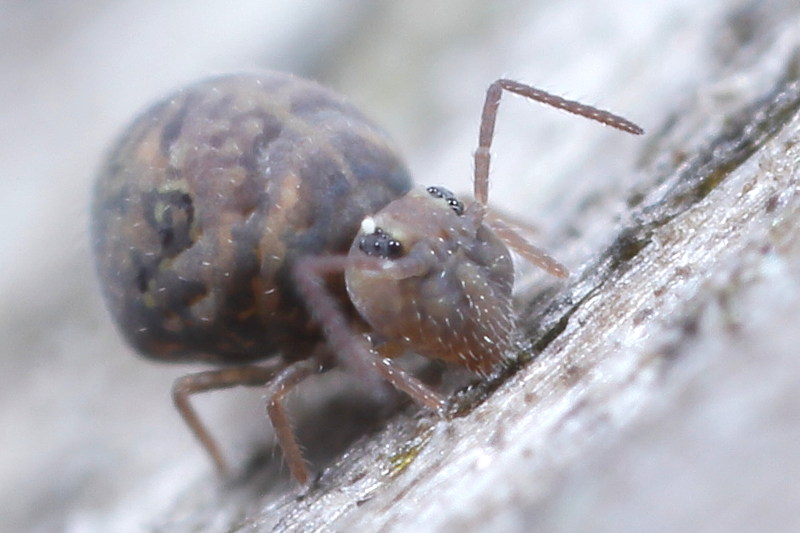
Cassagnaudiella pruinosa ♂
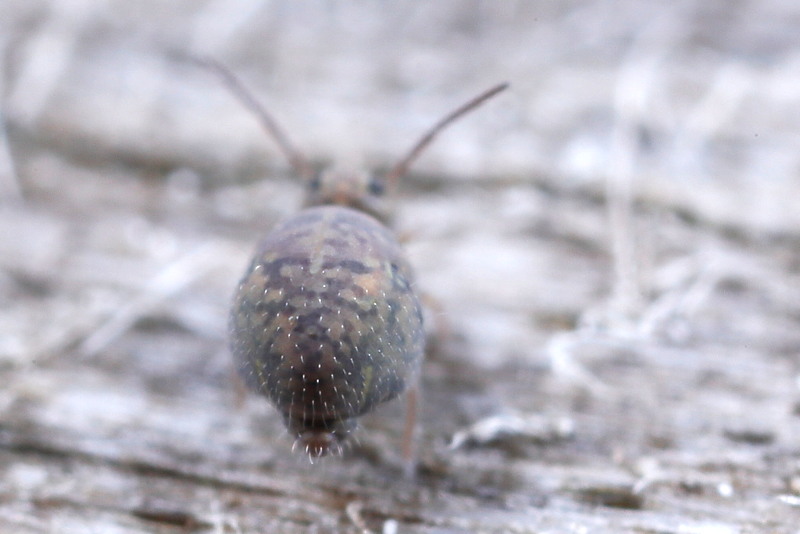
Cassagnaudiella pruinosa ♂
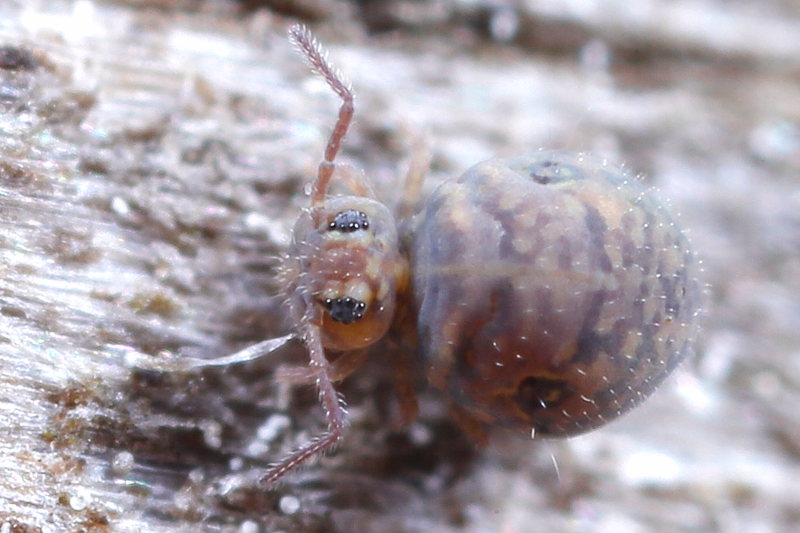
Cassagnaudiella pruinosa ♂

Cassagnaudiella pruinosa
Deuterosminthurus bicinctus (Koch, 1840)
There are three species of Deuterosminthurus in The Netherlands, Deuterosminthurus bicinctus is the easiest to distinguish, provided it is the form with two dark spots on the back. It is harder if you see completely yellow colored animals, which may be a yellow form of D. bicinctus but also D. pallipes or a female D. sulphureus. The men of D. sulphureus are to recognize to the color drawing and the D. pallipes also appears in a brown/purple color and is then clearly recognizable.
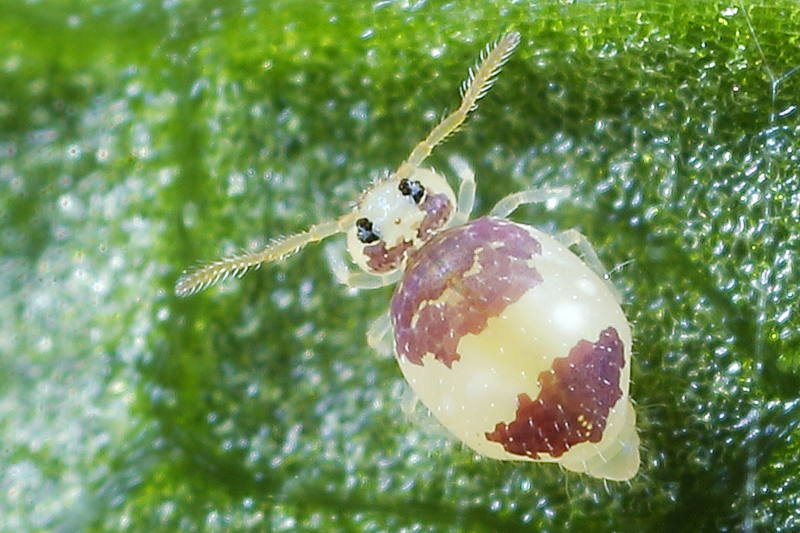
Deuterosminthurus bicinctus
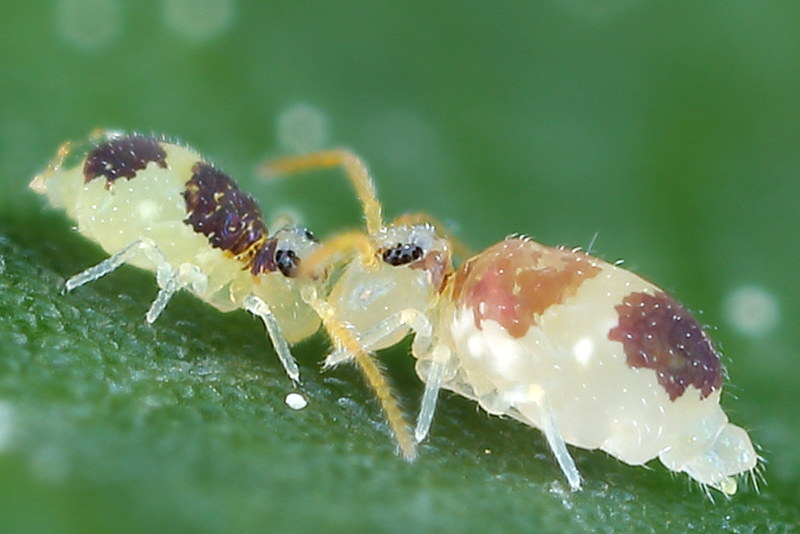
Deuterosminthurus bicinctus

Deuterosminthurus bicinctus
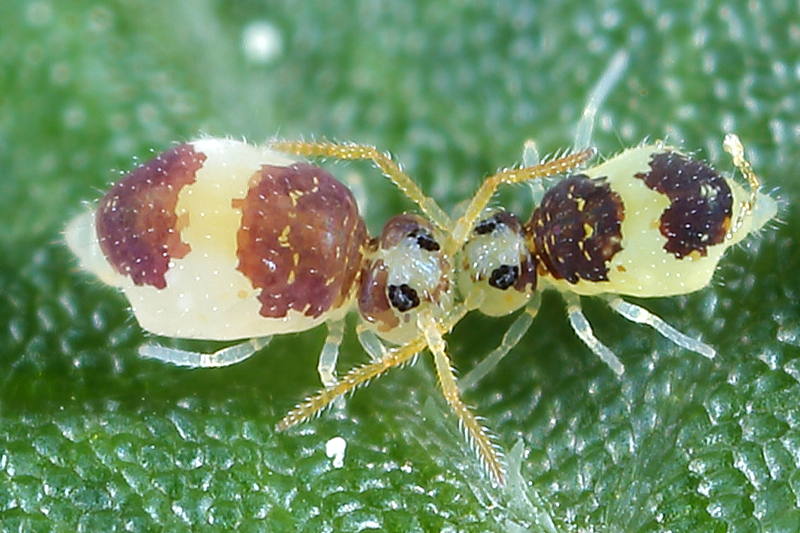
Deuterosminthurus bicinctus
Deuterosminthurus pallipes (Reuter, 1876)
If I have a newly created image of a beetle on the computer, I see two blurry springtails next to it. The picture was made in my garden, so back and see if I can find that springtail. They are very small springtails, less than 1 mm long, I had seen them walking, but which I had kept for mites. The animals run over the leaves of the plants. It succeeds to make some pictures of it. They have a long body and I think it are Deuterosminthurus pallipes, Frans confirmed that, this yellow form is called "repandus". The nominal form is dark purple, see the lower picture. Another species from the garden. It seems that there is an inexhaustible amount of species of springtails in the garden.
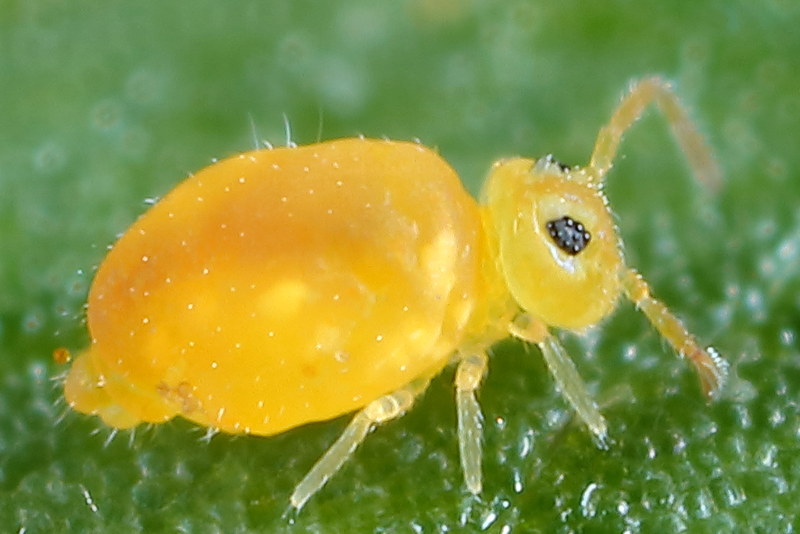
Deuterosminthurus pallipes forma repandus
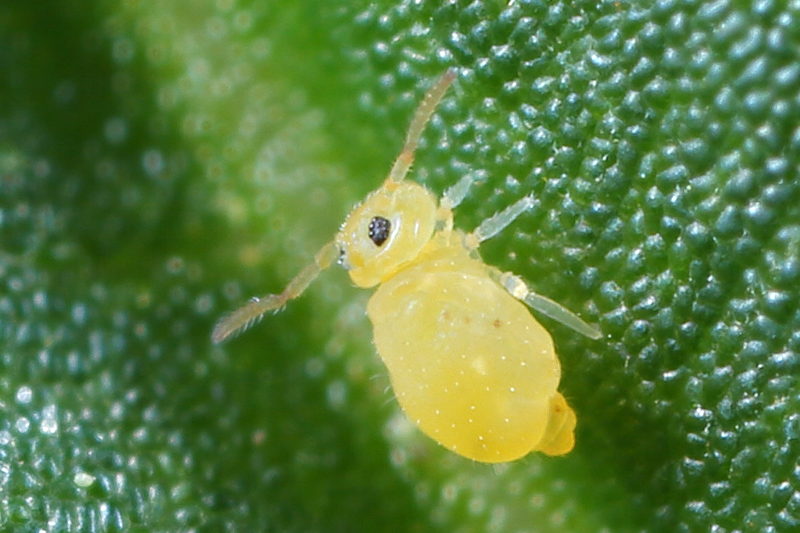
Deuterosminthurus pallipes forma repandus
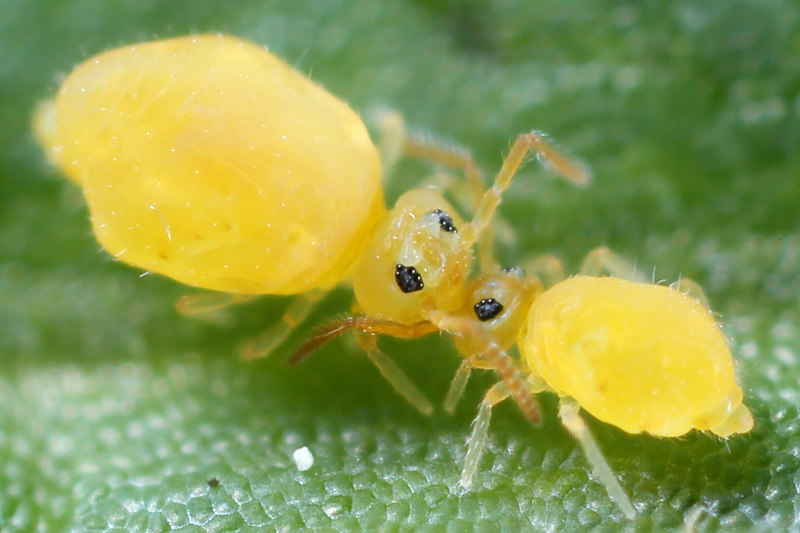
Deuterosminthurus pallipes forma repandus

Deuterosminthurus pallipes
Fasciosminthurus quinquefasciatus (Krausbauer, 1898)
I usually find the springtails in damp places under stones, branches and bark. However, there are species that are sitting in full sun on dry pieces of wood. This species Fasciosminthurus quinquefasciatus is one of them. On a very dry stretch of sandy land next to a railway station in Limburg is the only place you can find it in The Netherlands. The species was last year (2013) discovered by chance by André den Ouden, he made a picture of a Grasshopper and for the leg of this was a striped small beast. He asked at the site of waarneming.nl what kind this was. I then immediately recognized there this springtail. It was the first sighting of this species in The Netherlands. About a week later I'm at that place going to search, but to no avail. Today, 24-06-2014, I have more luck, I find there five specimens, two of which contribute to good shooting. It is a very small animal, so despite his striking drawing it is not noticed quickly.
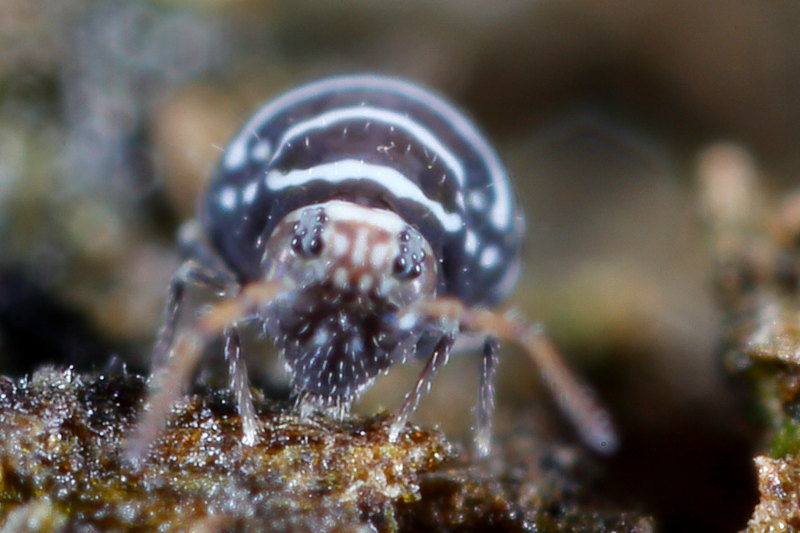
Fasciosminthurus quinquefasciatus
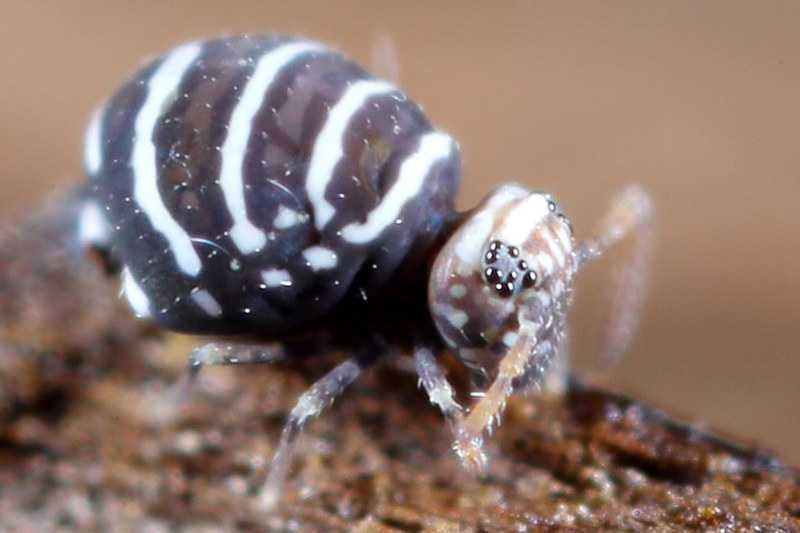
Fasciosminthurus quinquefasciatus
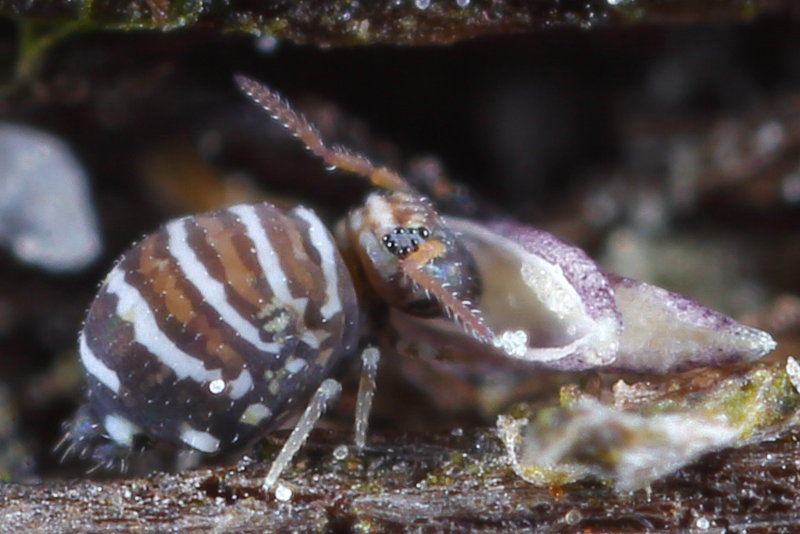
Fasciosminthurus quinquefasciatus
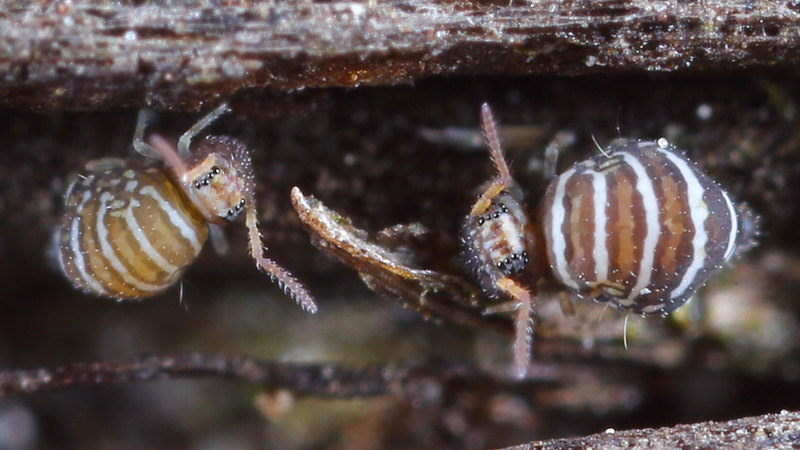
Fasciosminthurus quinquefasciatus
Heterosminthurus claviger (Gisin, 1958)
A beautiful striped springtail is Heterosminthurus claviger, found on the moors near Schoonloo in Drenthe in October. I've found on this site more special springtails. I don't know what the cause is, but for me it is a reason to go looking here often. The males have much longer antennae than the females and are also much faster.

Heterosminthurus claviger ♀
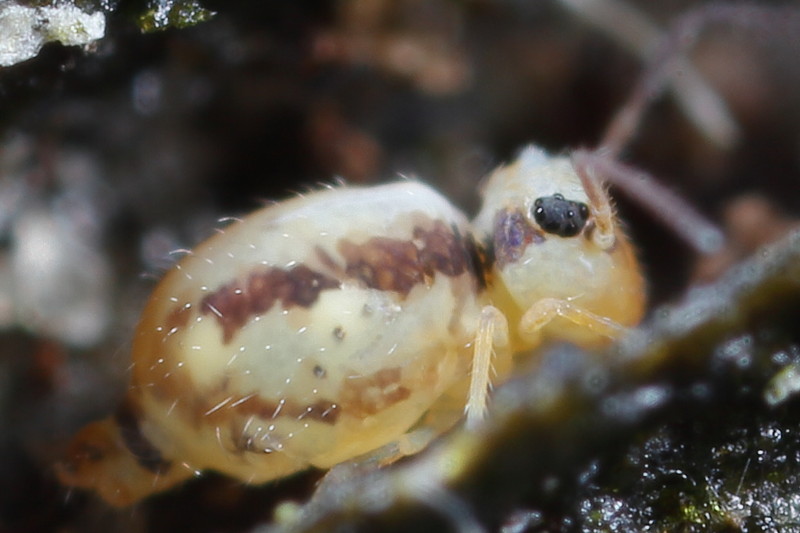
Heterosminthurus claviger ♀

Heterosminthurus claviger ♀
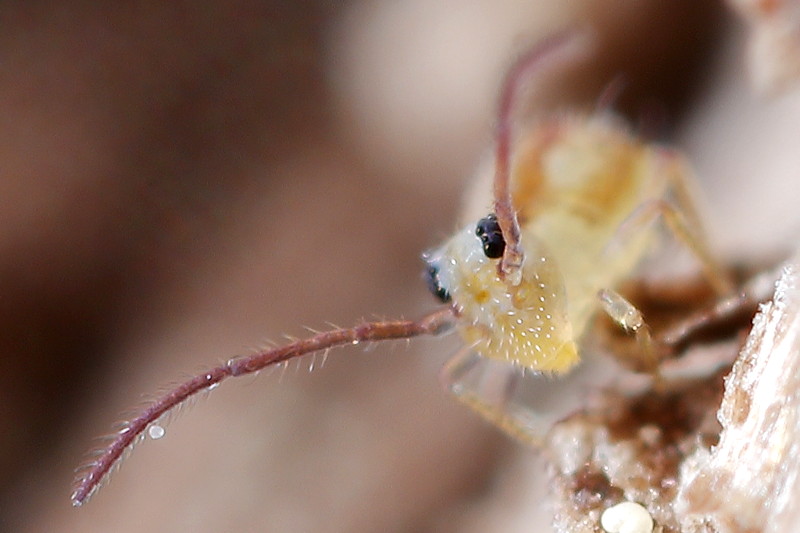
Heterosminthurus claviger ♂
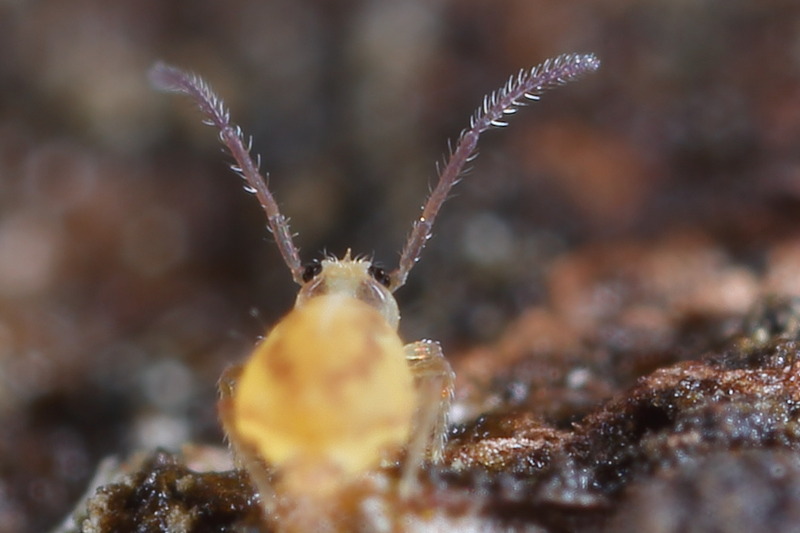
Heterosminthurus claviger ♂
Heterosminthurus insignis (Reuter, 1876)
In the Sun it looks like there are white patches around the eye-fields and also on the flash pictures that I make are on the small screen of the device white spots visible. At home on the computer the flash turns out to make the reflections, so the animal has a extremely shiny head. On the other hand, the body is dull and shows no reflection. This species I only found near water.
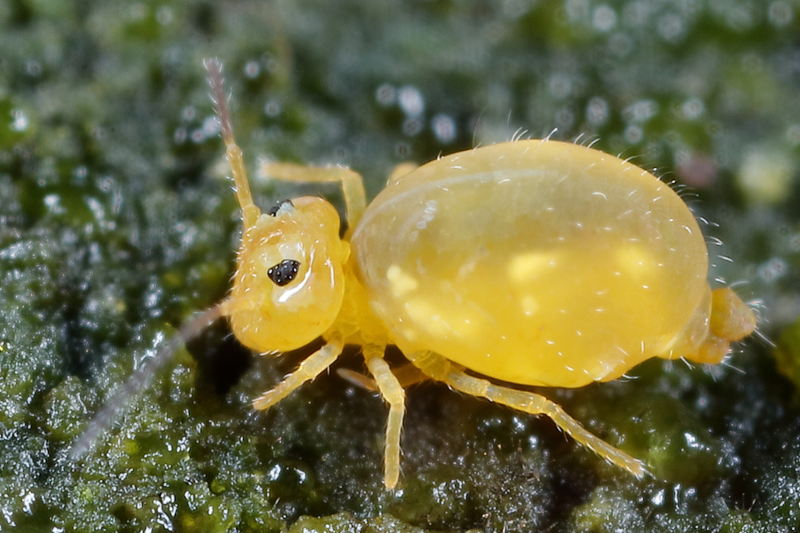
Heterosminthurus insignis ♀

Heterosminthurus insignis ♀
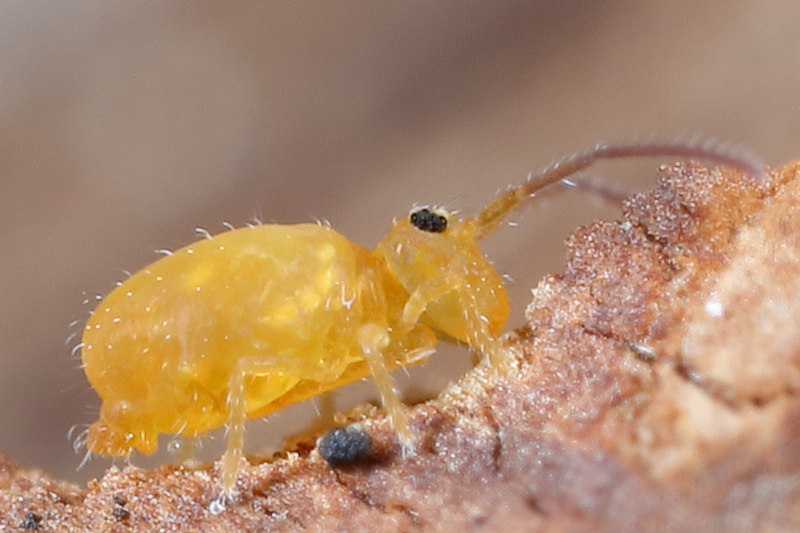
Heterosminthurus insignis ♂
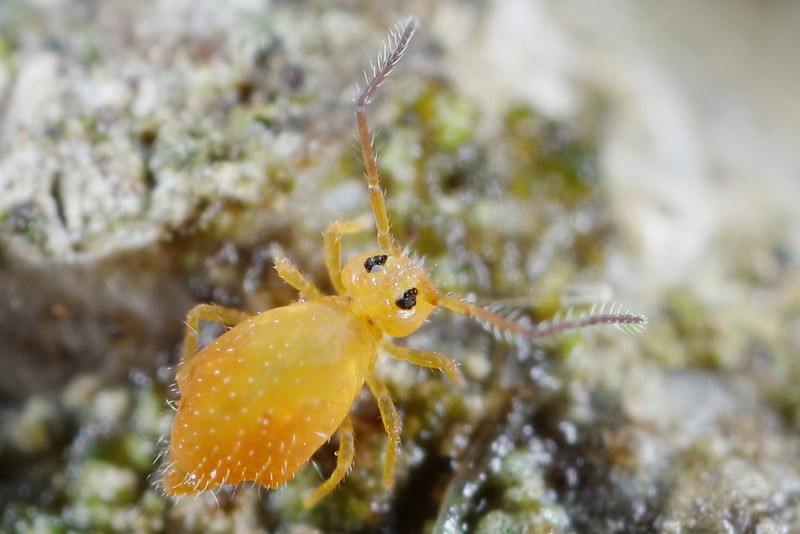
Heterosminthurus insignis ♂
Heterosminthurus novemlineatus (Tullberg, 1871)
A species of which I know only one place to find them in The Netherlands. Together with two friends, we have searched and with results, a number of specimens was found by us. They are beautiful striped animals who you can not mingle with other species.
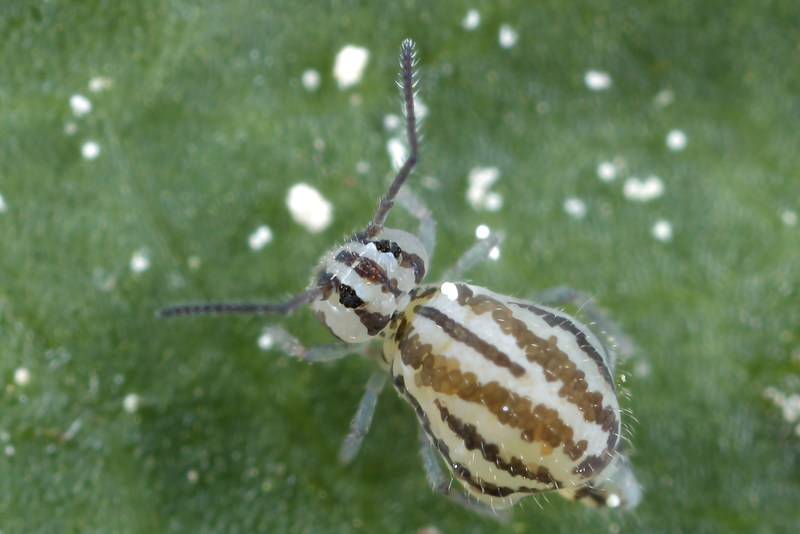
Heterosminthurus novemlineatus
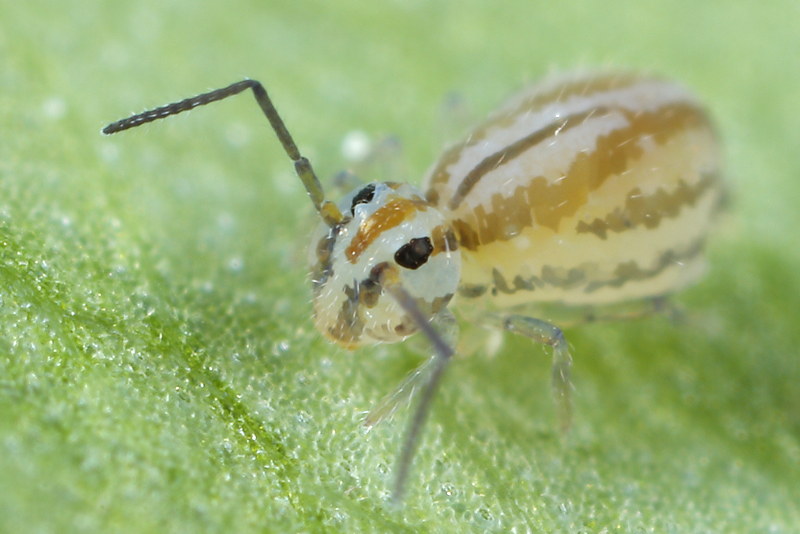
Heterosminthurus novemlineatus
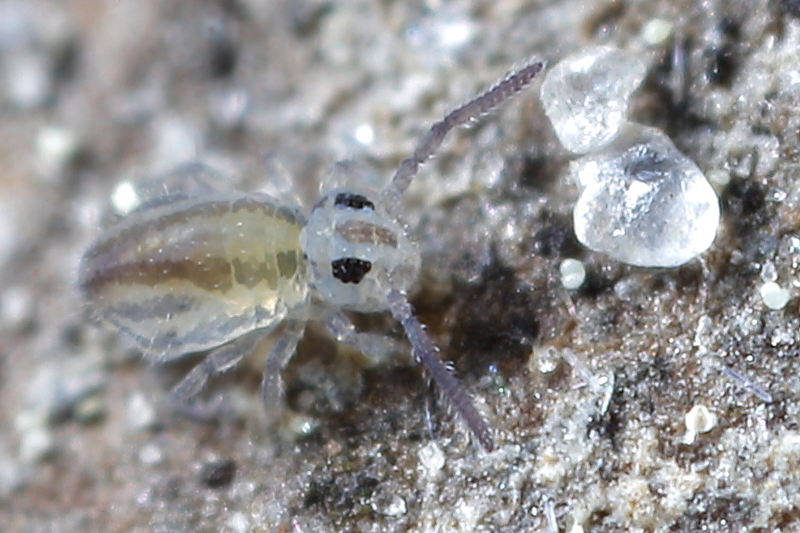
Heterosminthurus novemlineatus juvenile
(Calvatomina nr. superba) Now: Jordanathrix sp. 4
This springtail is quite small and could be just fairly common. After several years of only a few observations in The Netherlands I now see it regularly even in my own garden. It is also observed in Belgium. The species is provisionally declared as Calvatomina nr. superba which means it looks like Calvatomina superba. The preceding was changed to Jordanathrix sp. 4 (no. superba) but this name is also temporary, the species is still not officially described. In England it is pretty much found but there are also more people who fanatic search for springtails. The wait is now that the species is described and there is a name given to it. You can recognize it on the dark ocelli on a light background and the spots and stipes on the body.
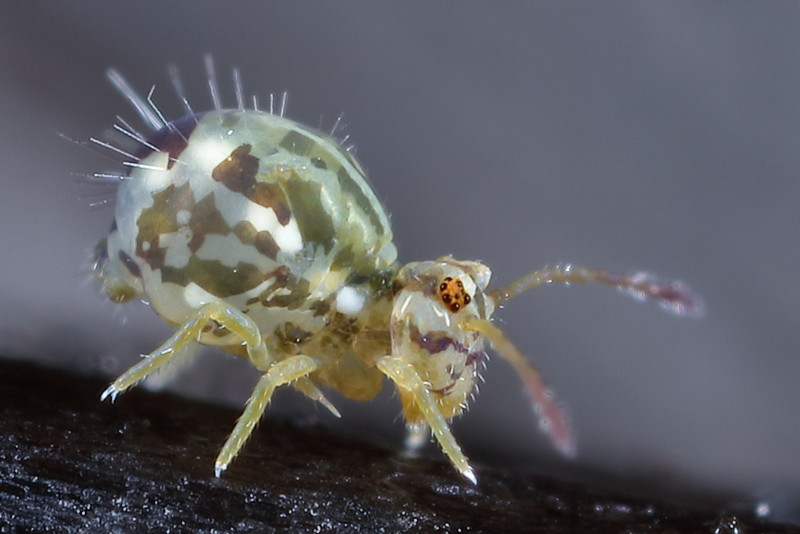
Jordanathrix sp. 4
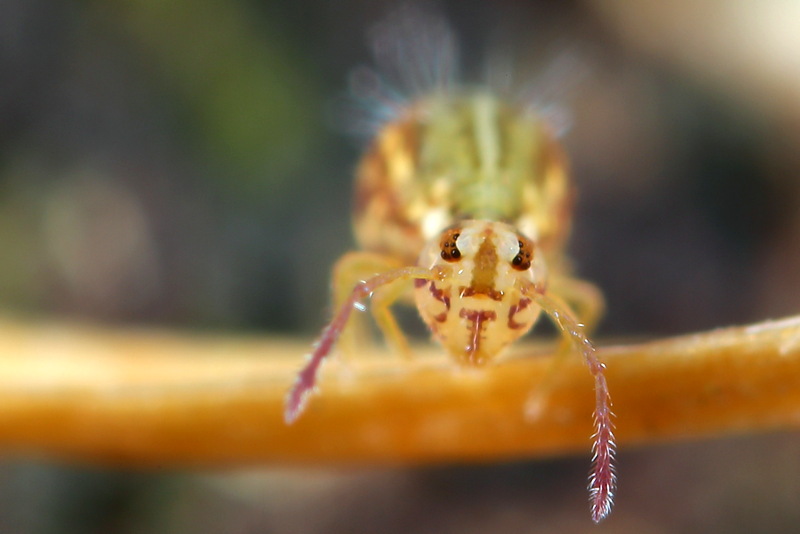
Jordanathrix sp. 4
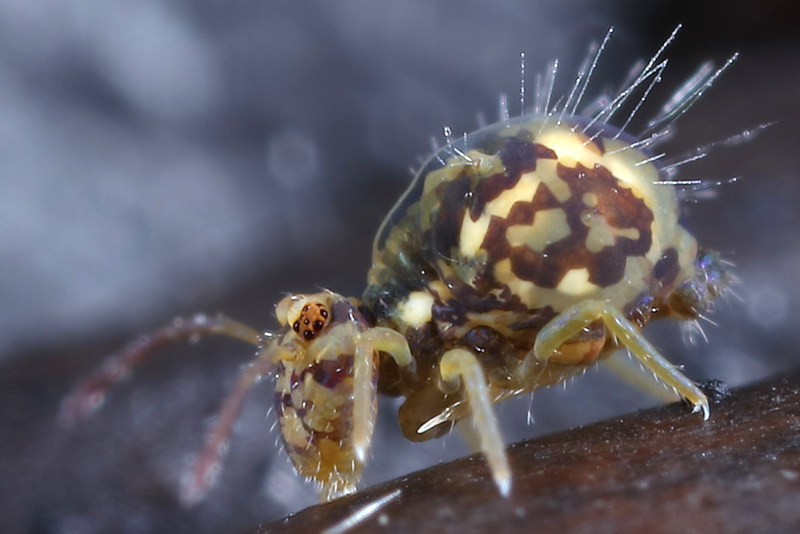
Jordanathrix sp. 4
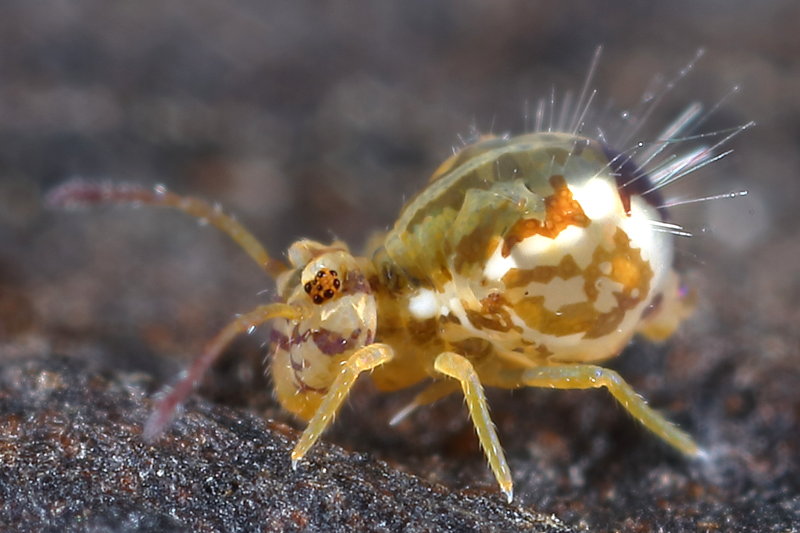
Jordanathrix sp. 4

Jordanathrix sp. 4
Dicyrtoma dorsosignata Stach, 1924
Again a new springtail in the Netherlands, from different sites. This species was known until now from southern Europe. The photos were taken on a completely black old tombstone. It is the only species I find on it. The colour variation in this species is particularly large.

Dicyrtoma dorsosignata
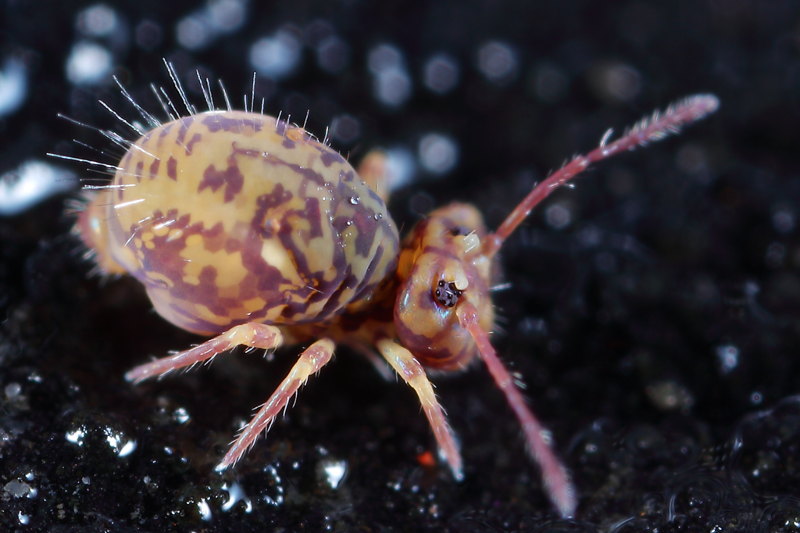
Dicyrtoma dorsosignata
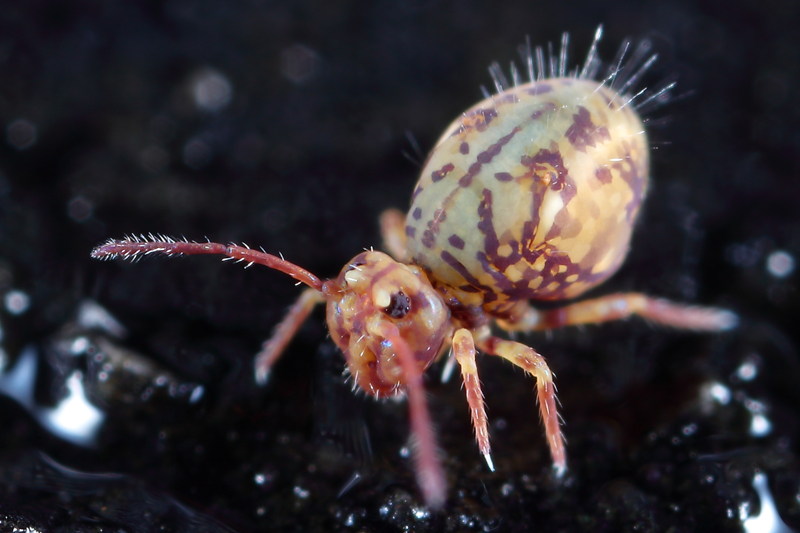
Dicyrtoma dorsosignata
Dicyrtoma fusca (Lubbock, 1873)
Some pictures of Dicyrtoma fusca the species
characteristics are clear;
The body is almost entirely red / brown.
In some animals you find a black stripe on the back, often there are several color variations of red and brown
on the animal.
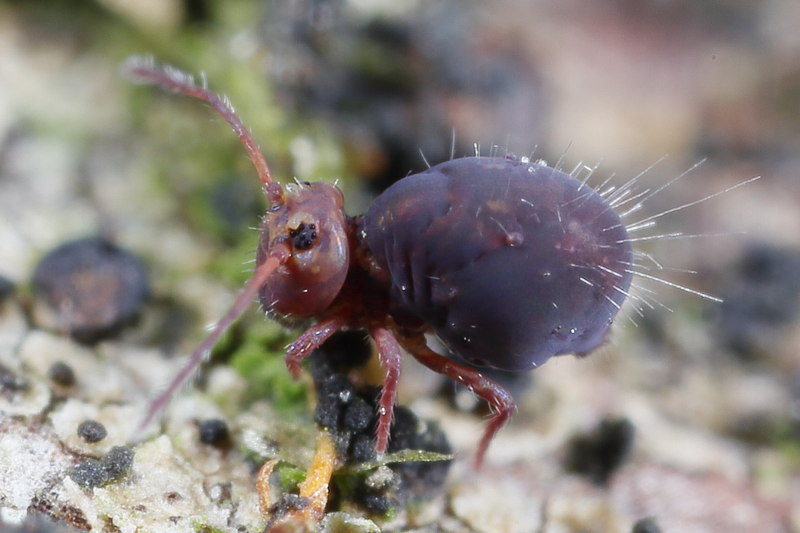
Dicyrtoma fusca
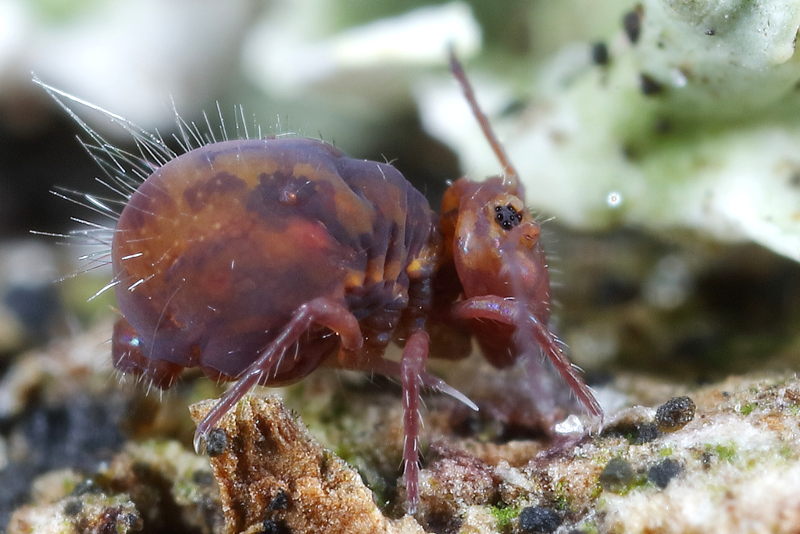
Dicyrtoma fusca

Dicyrtoma fusca var.1

Dicyrtoma fusca var.1
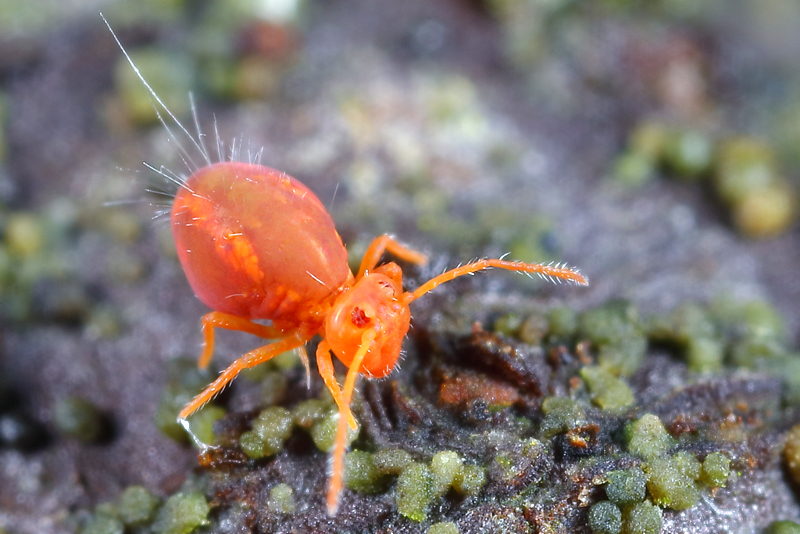
Dicyrtoma fusca, albino, missing black 28-12-2015

Dicyrtoma fusca, albino, 25-10-2022

Dicyrtoma fusca forma albella

Dicyrtoma fusca
Sometimes the animals have a slightly differend color, as this one who has white socks and a white area on the head. The cause of this white ends is that the animal goes molting. On the white places the new skin is already released from the old skin.

Dicyrtoma fusca

Dicyrtoma fusca, just moulted

Dicyrtoma fusca, juvenile
A remarkable form of Dicyrtoma fusca is the variant rufescens, named after the first assumption that it would be Calvatomina rufescens, as he was called for five years. Now it is clear that it is a color variant from Dicyrtoma fusca. At this variant the ocelli are not placed on a dark background but on a bright yellow background.

Dicyrtoma fusca var. rufescens
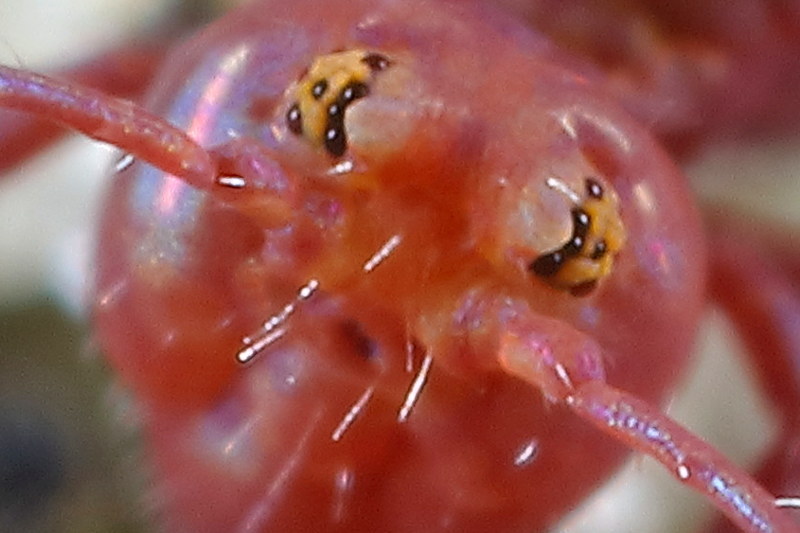
Dicyrtoma fusca var. rufescens
Sometimes the differences between the types of springtails are minimal, sometimes there are large differences between the individuals and it is the same species, or maybe not? At the Bank of the Waal at Nijmegen in the Ooijpolder I see that Arp Kruithof photographs a bristletail with a springtail next to it. I'm excited because I think the animal is a new species for me. Hay Wijnhoven luckily finds a couple springtails where I can take pictures of. Frans Janssens identifies him as Dicyrtoma fusca var.2 a shape that is mentioned twice before in 2006 and 2010 from the Czech Republic.
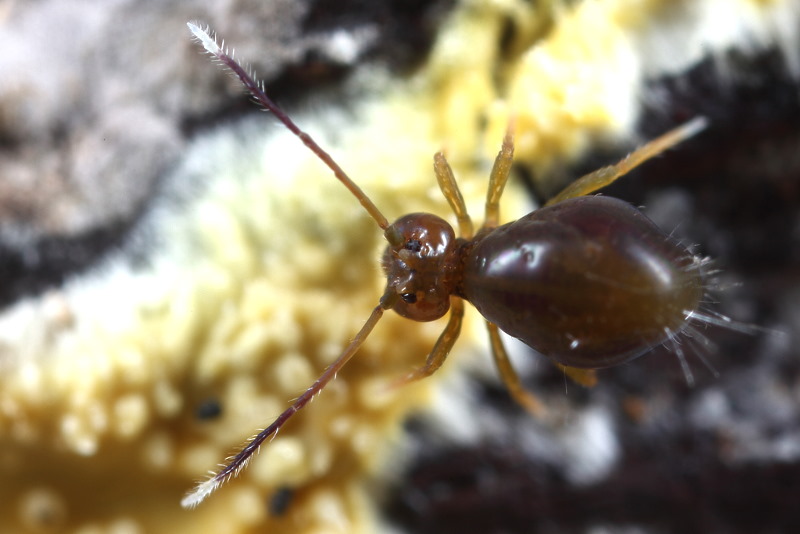
Dicyrtoma fusca var.2

Dicyrtoma fusca var.2
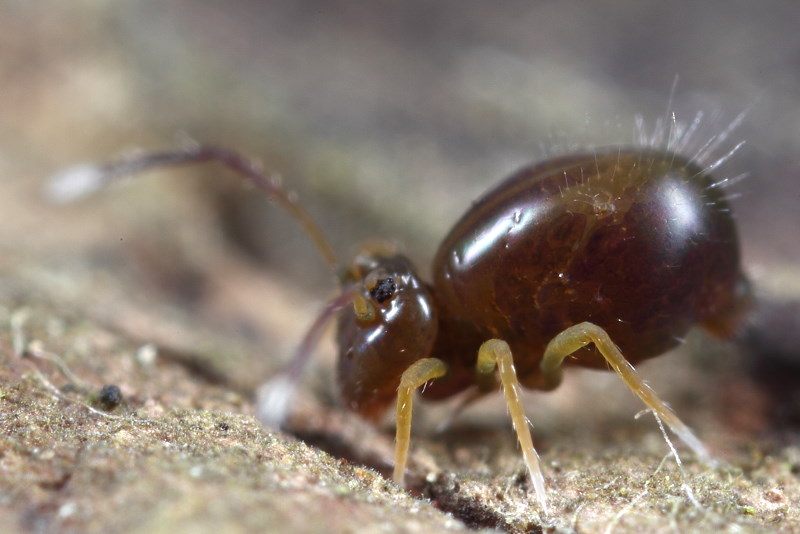
Dicyrtoma fusca var.2
Dicyrtomina minuta (O. Fabricius, 1783)
I have finally found a convincing specimen of Dicyrtomina minuta. This animal is really yellow, without drawings on the back that are also to be found in the other species of Dicyrtomina. I've found the animal in a nature area at Woudbloem in Groningen on 23-12-2011.
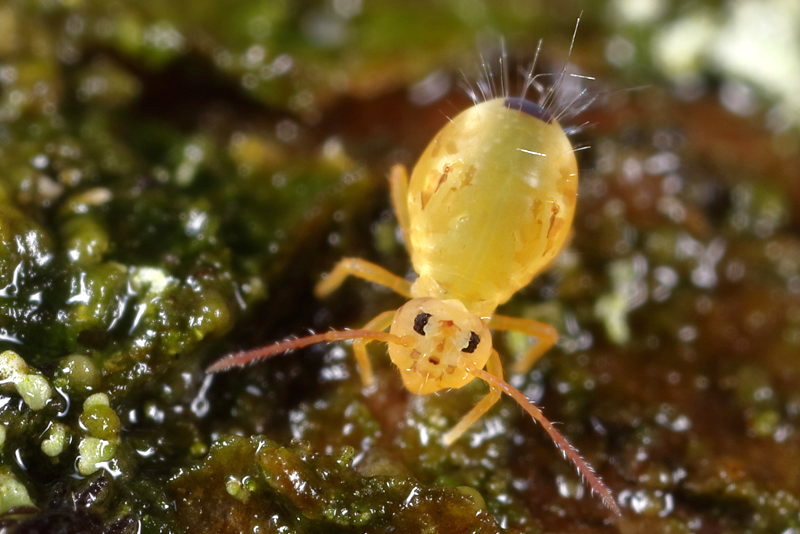
Dicyrtomina minuta

Dicyrtomina minuta
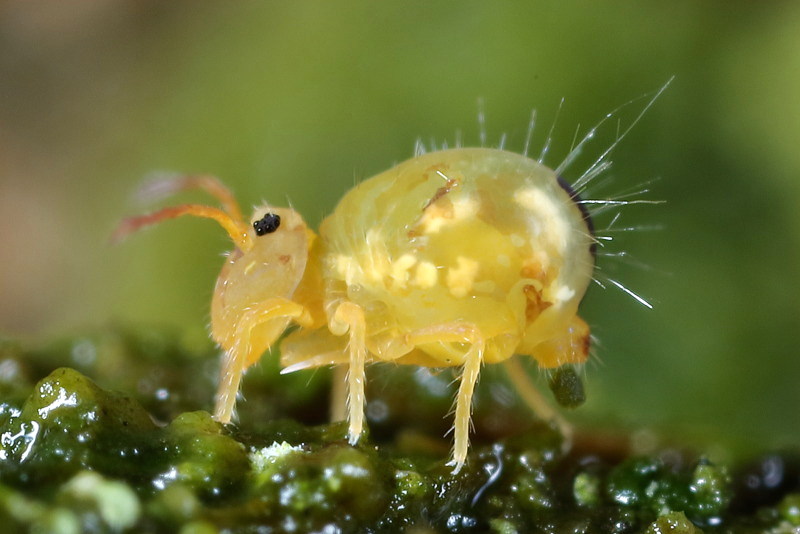
Dicyrtomina minuta
It is rather difficult to distinguish young animals of the species ornata and saundersi from minuta, therefore also two pictures of light coloured animals of the other species.
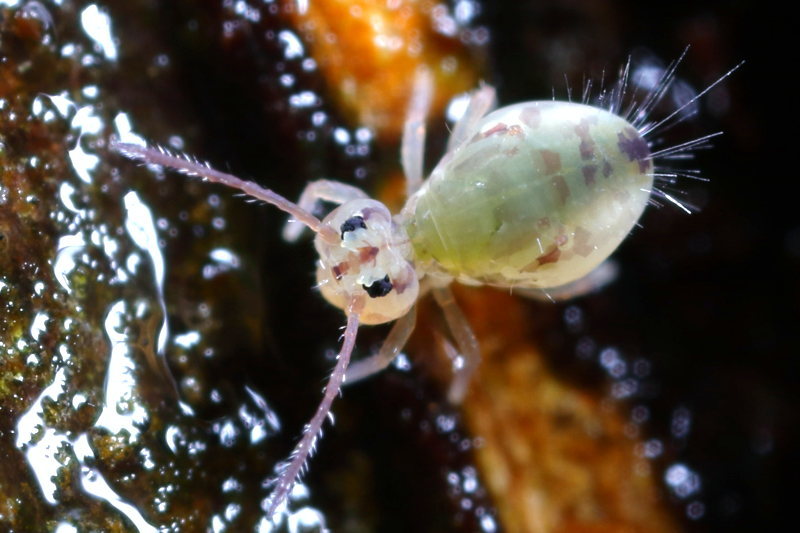
Dicyrtomina ornata
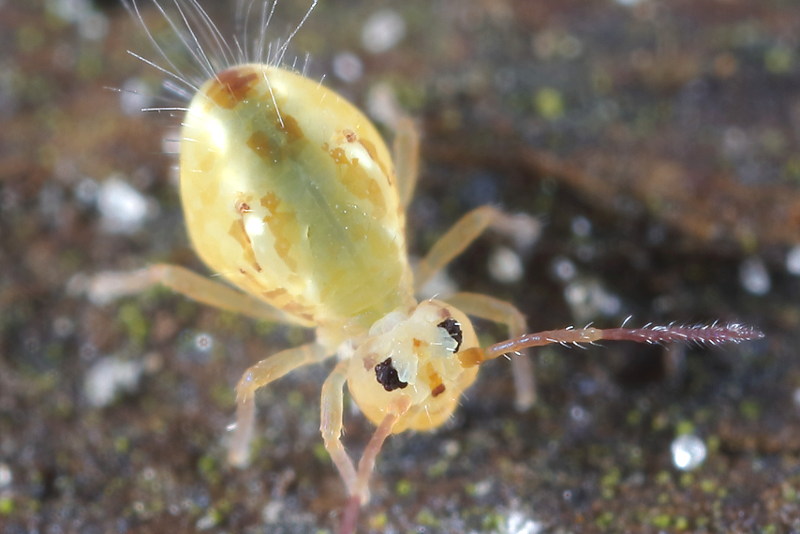
Dicyrtomina saundersi
Dicyrtomina ornata (Nicolet, 1842)
A real winter species is Dicyrtomina ornata. You see the animals from october to may. Although declared as scarce I have a very different impression. In the winter half-year it are almost the most common animals. Currently, 29-11-2013, from each fallen leaf that you pick up, jump away some animals of this species. They can be found along with the Dicyrtomina saundersi, also a species from the same winter half-year and Dicyrtoma fusca, from witch the last one is not present so massive. From D. saundersi I have the impression that I see that more in the forest. D. ornata is quite variable in color, which is annoying because the difference with D. saundersi sometimes is very unclear. The best features are the black spot on the back and the antennae that have but one color. The large cross behind the head is typical. Both very light and very dark specimens of this species occur.

Dicyrtomina ornata

Dicyrtomina ornata
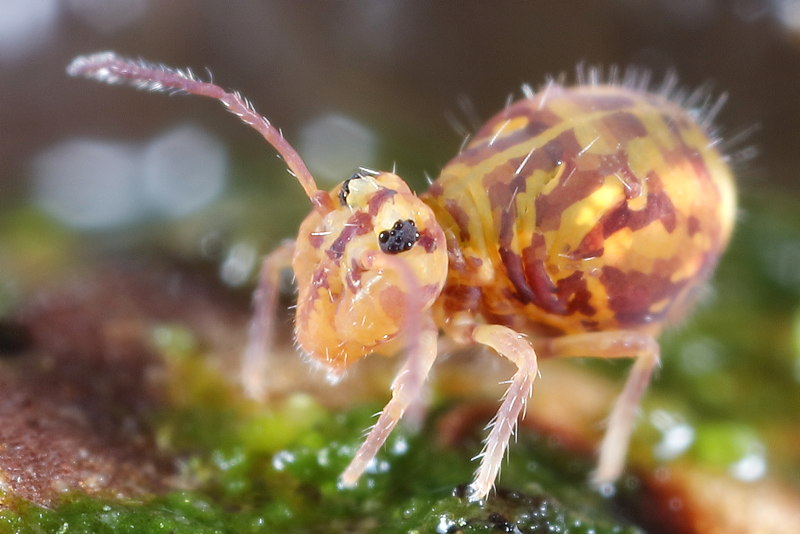
Dicyrtomina ornata

Dicyrtomina ornata
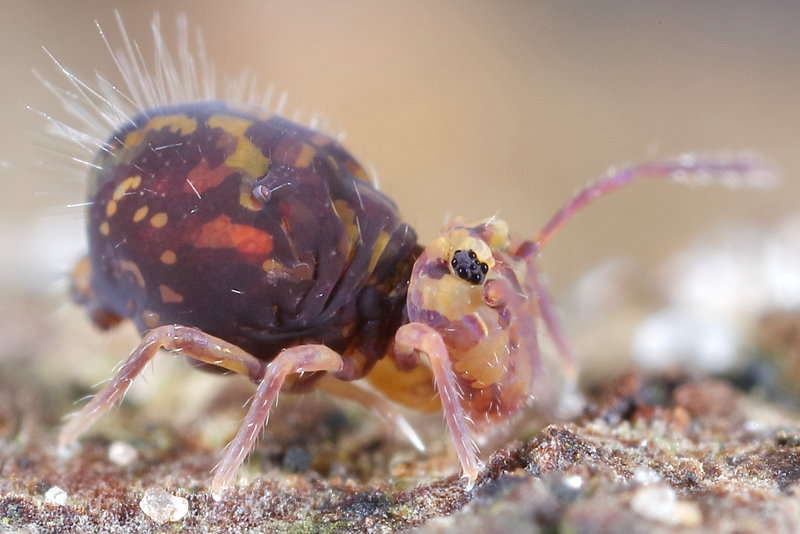
Dicyrtomina ornata
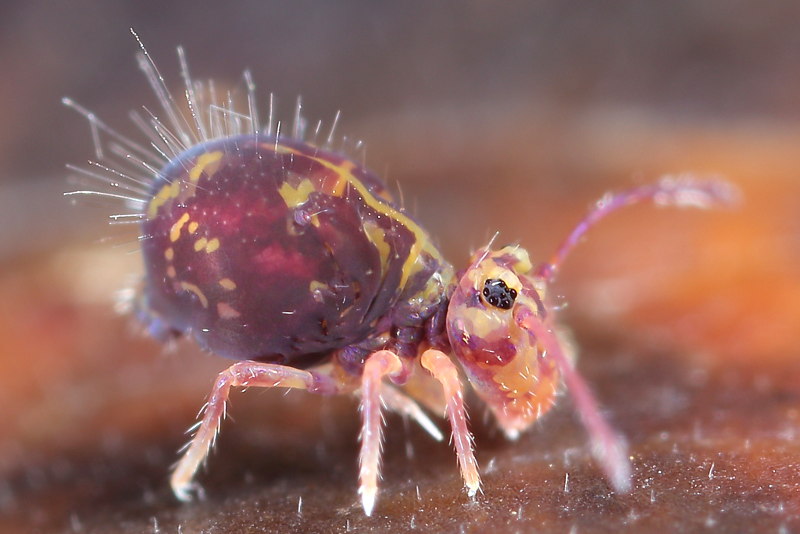
Dicyrtomina ornata

Dicyrtomina ornata
Dicyrtomina saundersi (Lubbock, 1862)
Dicyrtomina saundersi is one of the species that occurs in the autumn here in the surroundings (garden, forest) in truly unimaginable numbers. Together with Dicyrtomina ornata in favorable weather they are really everywhere. These two species were the cause that I began to get interest in springtails. Still I find them beautiful in color and drawing. At the beginning I had great difficulty to distinguish them from each other, especially if they were not yet fully grown up. Nowadays I hardly mistaken me into it and I recognize them even without magnifying glass to their overall appearance and color. Big difference is the black spot on the back of the body. At saundersi multi-barred cross, at ornata a more or less rectangular irregular stain. Is this not showing then you look to the antennas. At saundersi there is always a sudden colour change of the final segment to the next segment. The drawing behind the head on the back is also very characteristic.
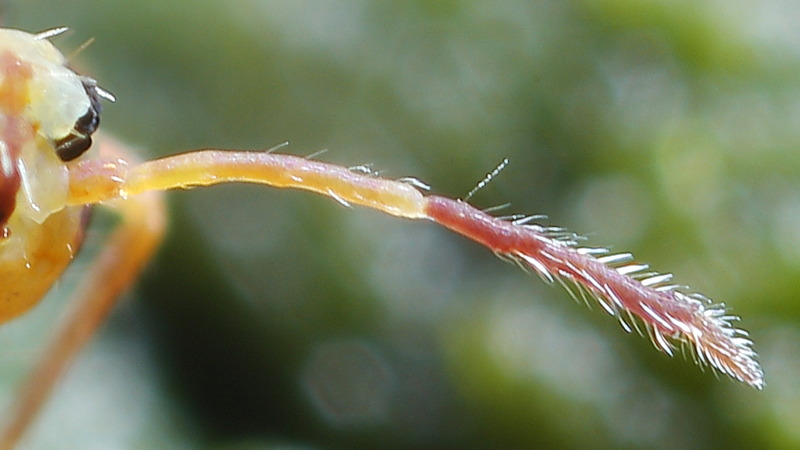
Dicyrtomina saundersi
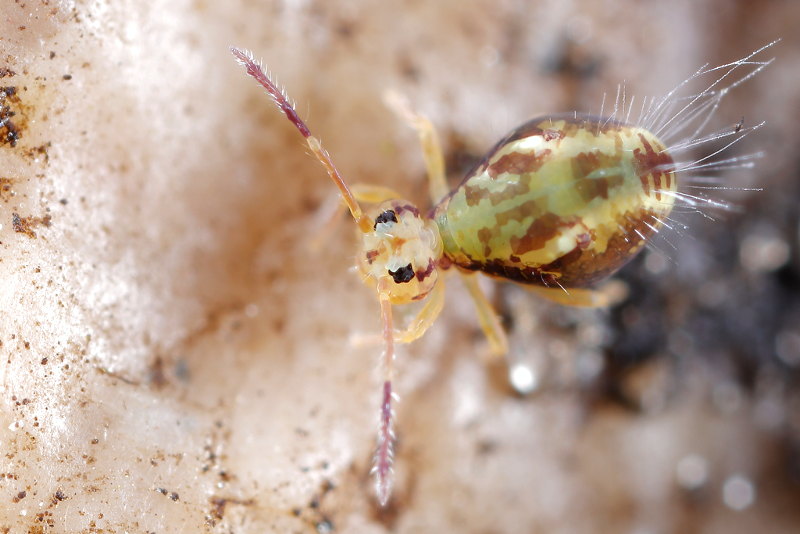
Dicyrtomina saundersi
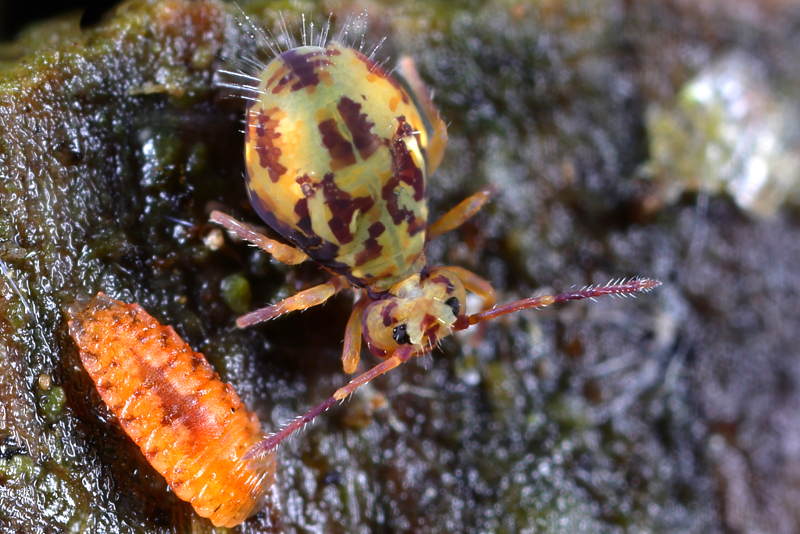
Dicyrtomina saundersi
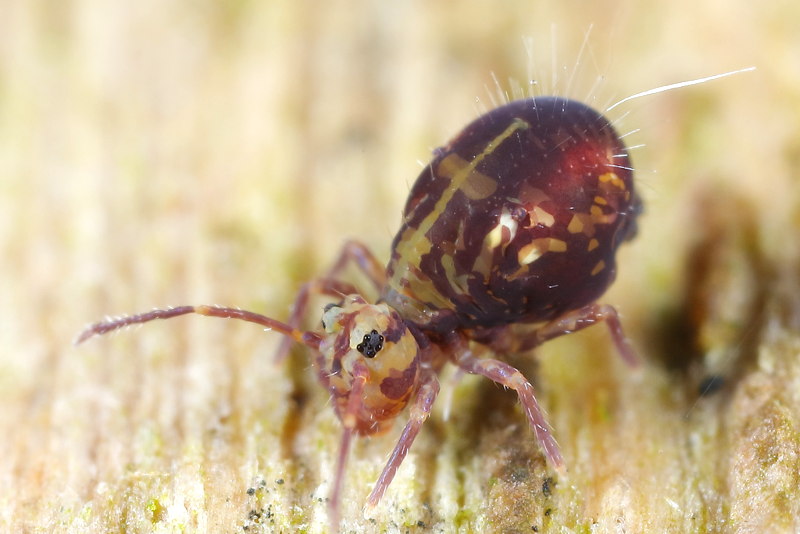
Dicyrtomina saundersi
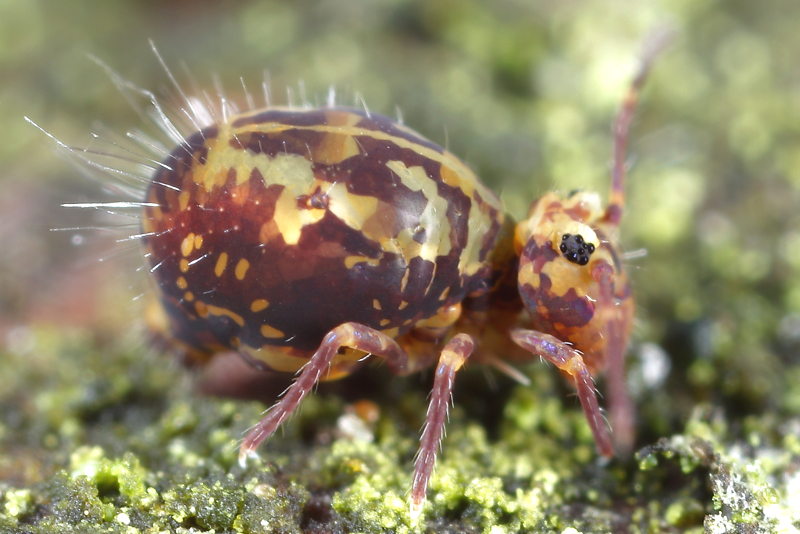
Dicyrtomina saundersi
Gisinianus flammeolus (Gisin, 1957)
Assuming that I made pictures of Sminthurinus aureus, I do put a picture on Flickr.com where Frans Janssens points out that the 5th abdominal segment is not fused with the great abdomen. Than Gisinianus flammeolus is really only eligible, a rare species but it is possible that this species is often not recognized. In any case, this is the first observation in the Netherlands, made on 3 February 2015.

Gisinianus flammeolus

Gisinianus flammeolus
Katianna schotti (Womersley, 1933)
18-11-2015. While searching and photographing Jordanathrix sp. 4 I make some pictures and if I lose the animal I look on the camera and see that there is a whole other animal species. Right away I recognize a Katianna, I have seen pictures of these species of animals from England and have been wanting a long time to photograph such a fun springtail. In the garden of a friend of mine I really didn't expect it. After I have looked it up at collembola.org it appears to be the first sighting in The Netherlands and even the first record from the European continent. On 18-12-2015 I find a different coloured springtail that looks much alike. This time on a place in a forest where many foreign conifers are planted. After consultation with Frans Janssens it turns out to be a female of the same species. There is therefore dimorphism in this species, male and female are coloured different. It is originally a species of the southern hemisphere, which came along with plants. In England, the species was for several years ago for the first time encountered in Sheffield Botanic gardens.

Katianna schotti ♂
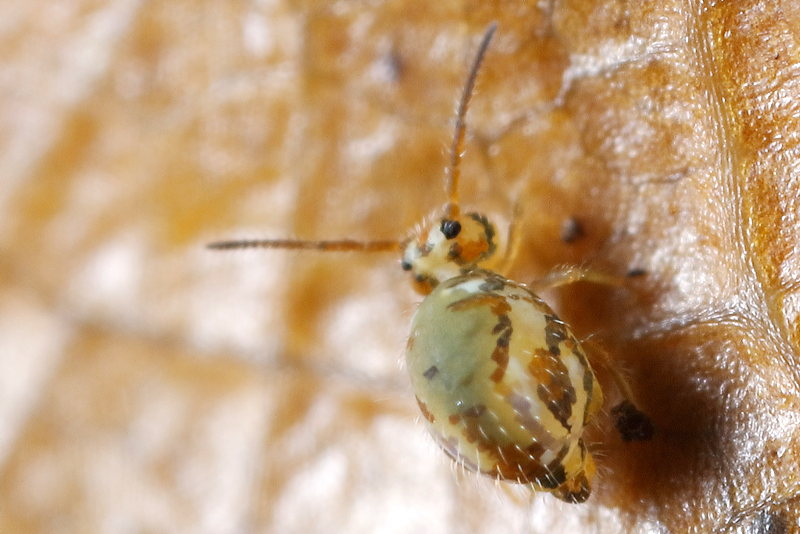
Katianna schotti ♂

Katianna schotti ♀
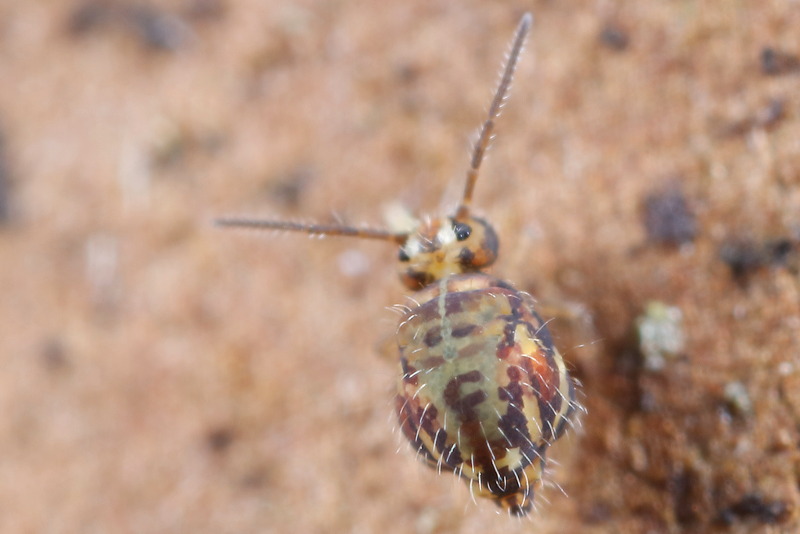
Katianna schotti ♀
Sminthurinus aureus (Lubbock, 1862)
On the underside of old bark and on fallen wet branches with algae, you often see small globular springtails. They are yellowish brown sometimes black in colour and also when temperature is below freezing point and you do not see any other species of springtails you will still find this one. The color of this animal is so variable that there were names given to the different forms, such as on the photo shown of the forma ochropus. They are up to 1 mm long.
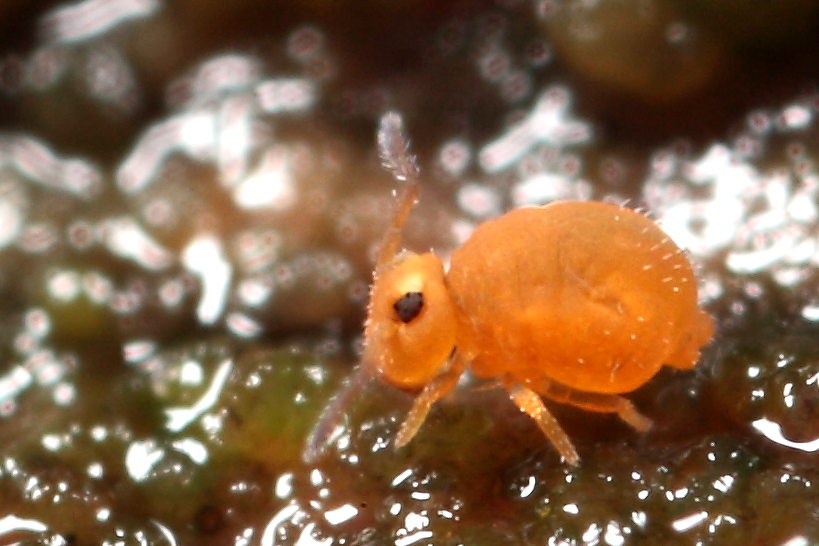
Sminthurinus aureus

Sminthurinus aureus
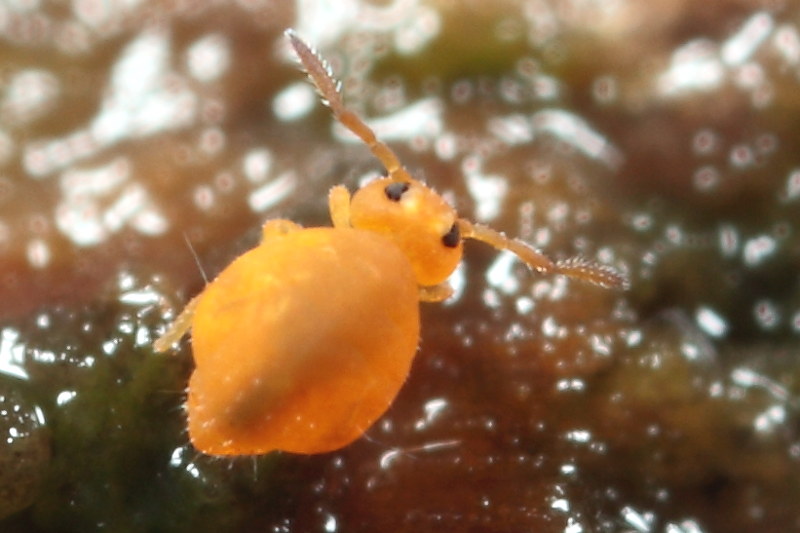
Sminthurinus aureus
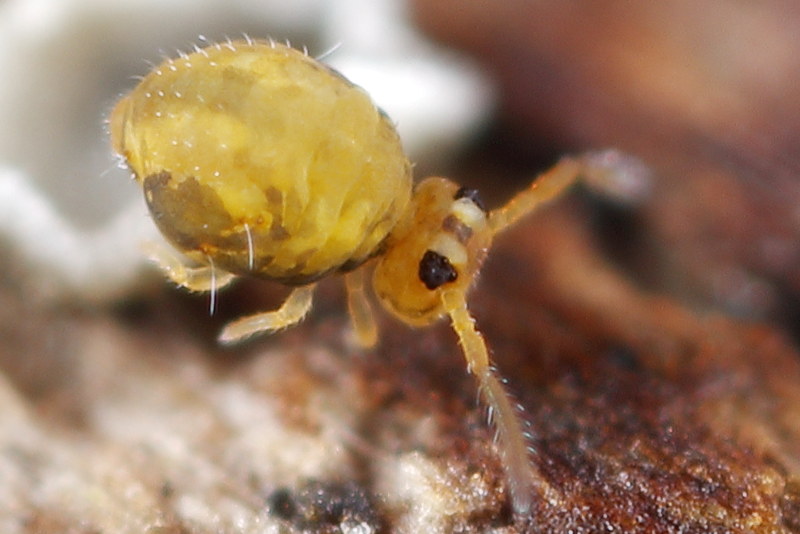
Sminthurinus aureus
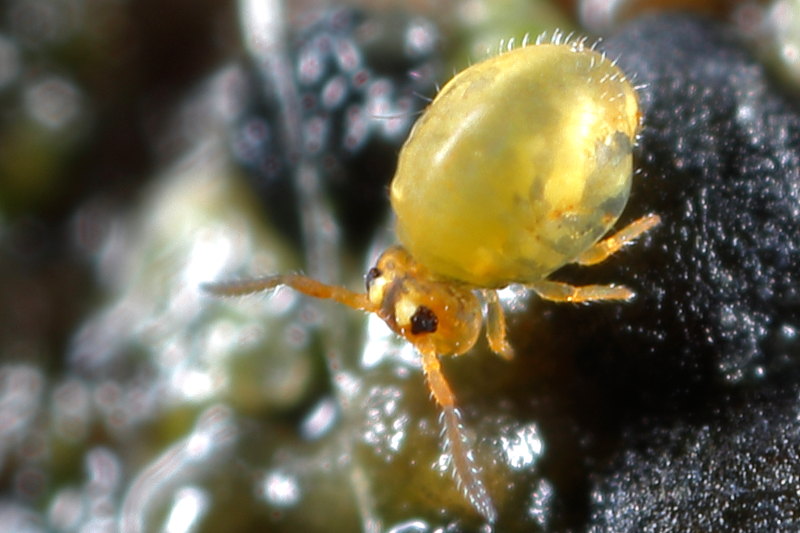
Sminthurinus aureus

Sminthurinus aureus

Sminthurinus aureus f. ochropus

Sminthurinus aureus f. atratus

Sminthurinus aureus
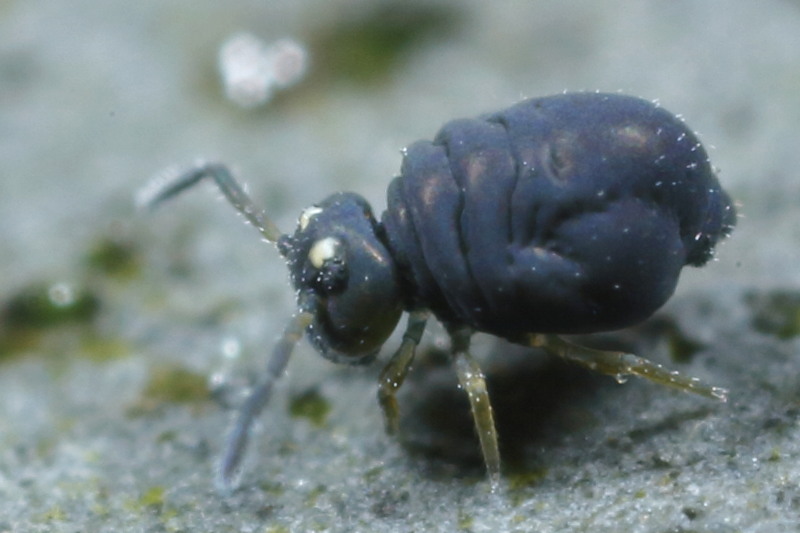
Sminthurinus aureus
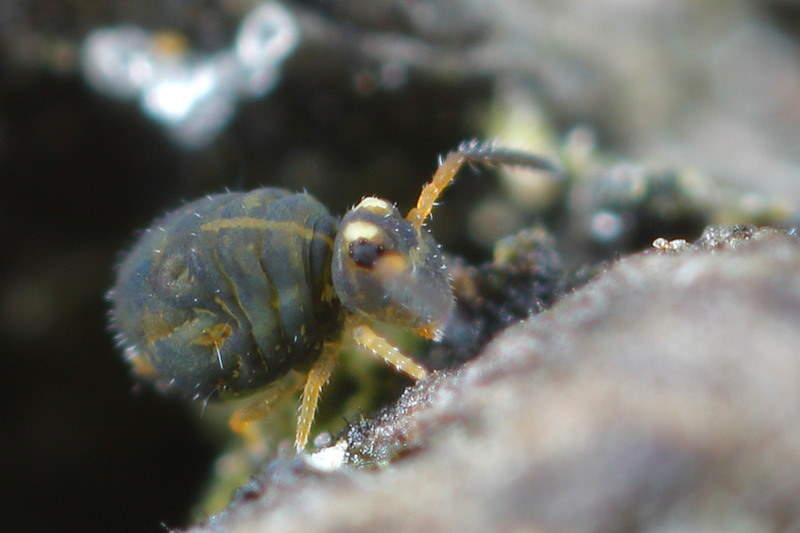
Sminthurinus aureus f. reticulatus
Sminthurinus domesticus (Gisin, 1963)
According to the University of Roehampton London the origin of this species is not clear, it is found in greenhouses in England and not just outside. One assumes that it has come along with plants, but does not knows from where. The animal is identified by the colored spots between the eyes, the top one is yellow/white, the lower reddish. The animals are small, about 1 mm. Sometimes they sit in small numbers under flower pots in the unheated greenhouse, if seeds are sown which grow slowly and which are kept very wet, moss and algae grows on the potting soil and in between they come often in large numbers. There are several colour forms, the young animals are greenish or brown and sometimes a striking dark yellow colored form with red eyes, an albino form.
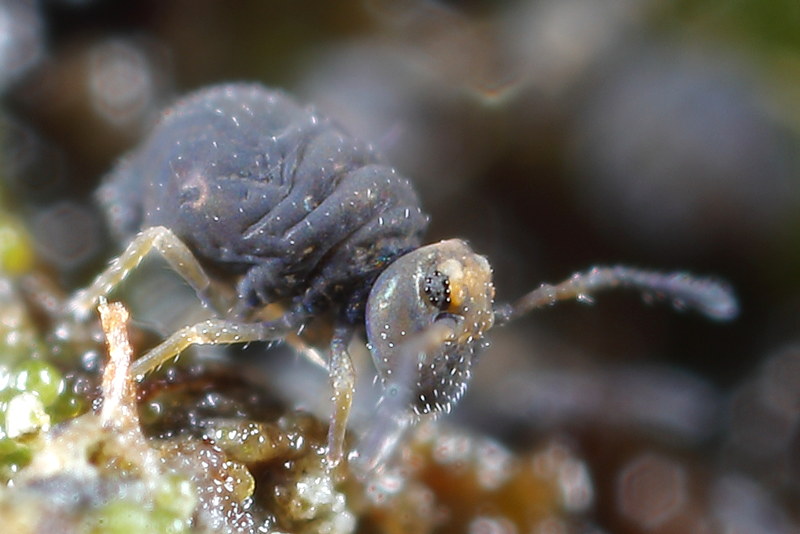
Sminthurinus domesticus
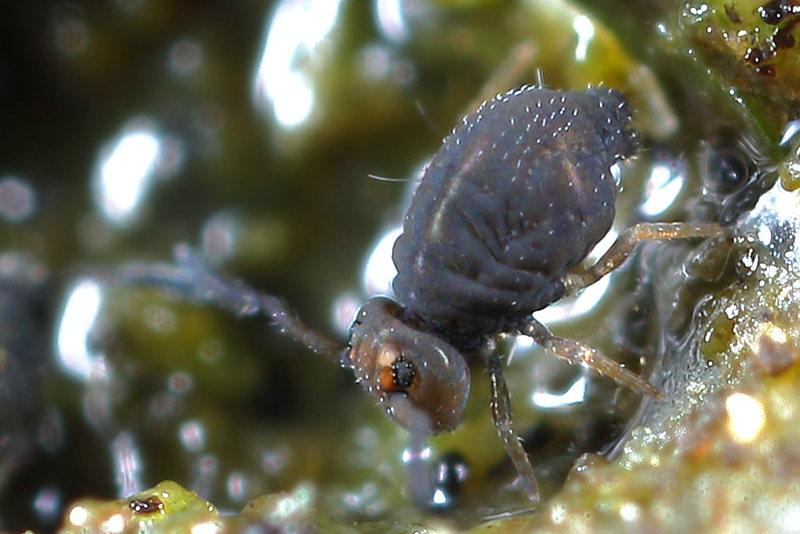
Sminthurinus domesticus
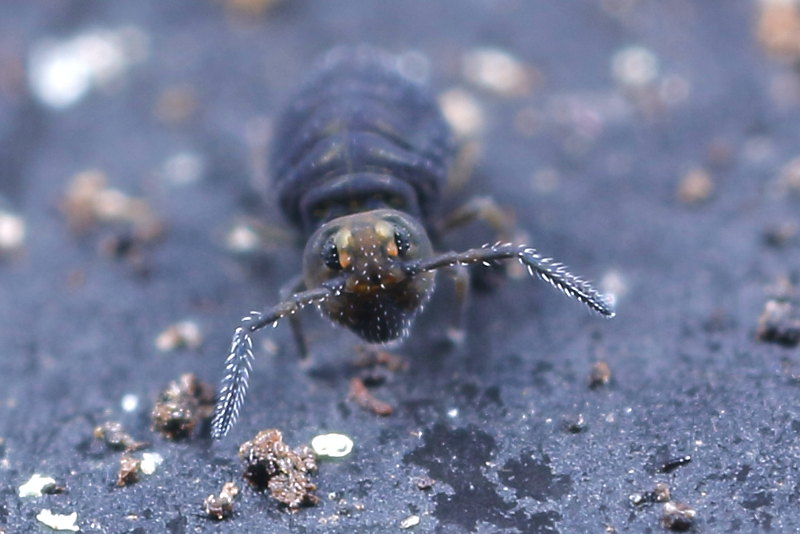
Sminthurinus domesticus
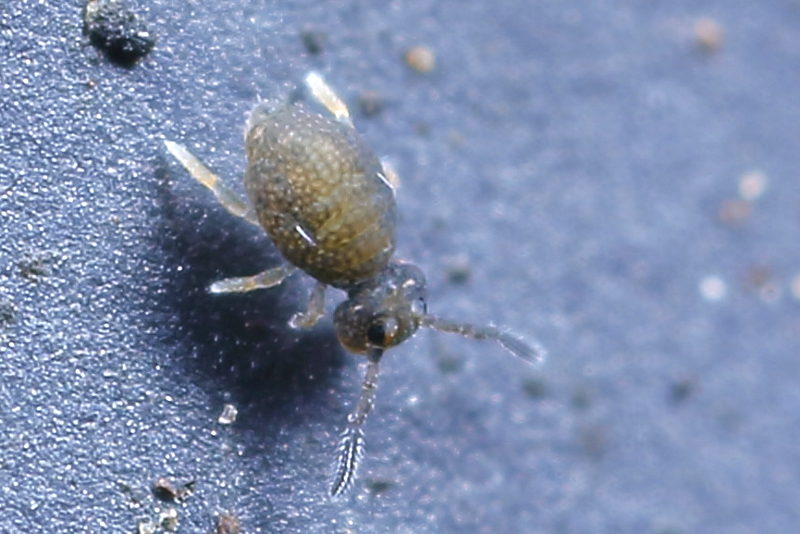
Sminthurinus domesticus, juvenile
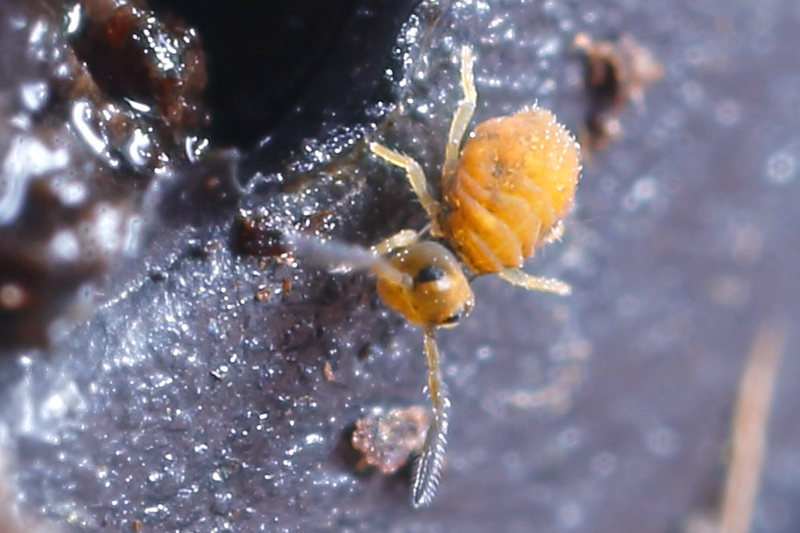
Sminthurinus domesticus

Sminthurinus domesticus
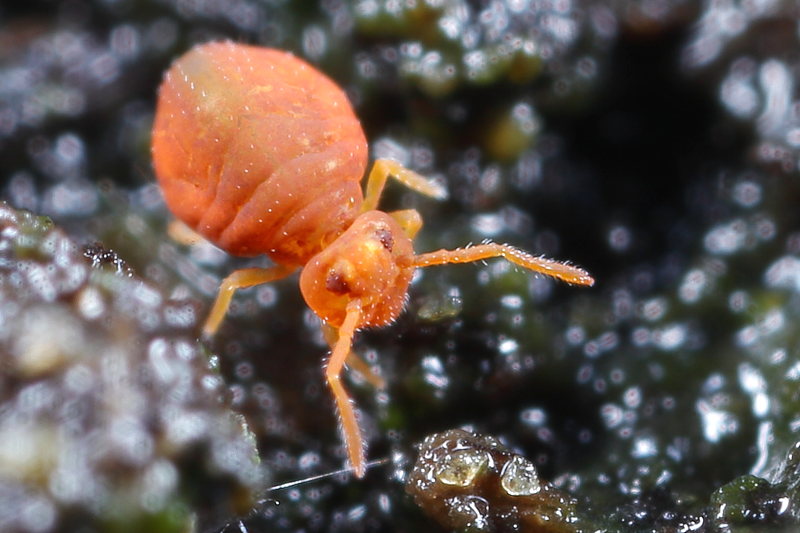
Sminthurinus domesticus f. apigmentata
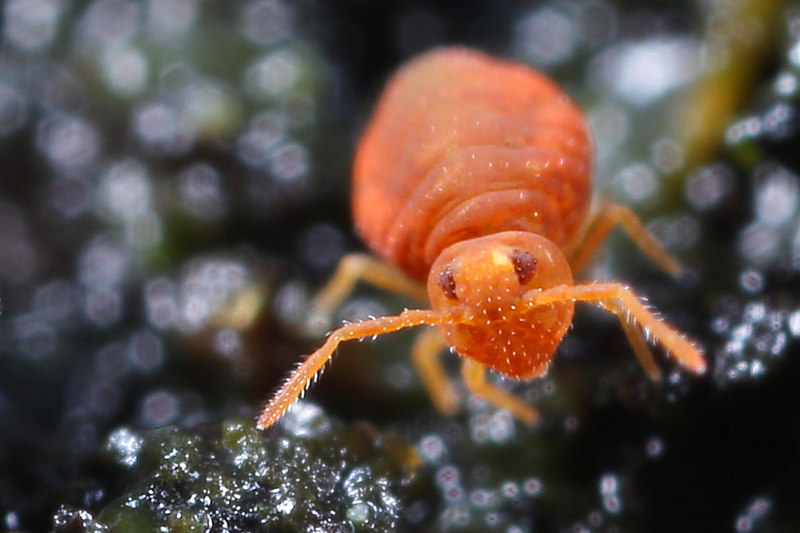
Sminthurinus domesticus f. apigmentata
Sminthurinus elegans (Fitch, 1863)
In the private garden sits under a dead oak leaf a very small springtail with two dark brown stripes along the sides and a not continuous line across the back. Behind the middle stripe is a cross stripe that connects the adjacent stripes. This species is up to 0.7 mm long. At the sight of the animal I immediately think of Sminthurinus elegans because I know of the animal sightings from England and Germany and I have long been waiting to finally see it. A day later I photograph a color form in the garden where the median line is missing, forma ornata.
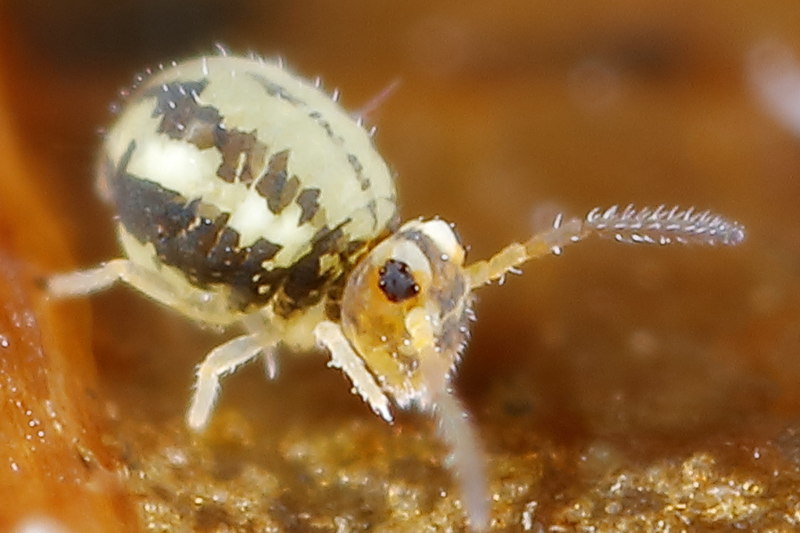
Sminthurinus elegans

Sminthurinus elegans
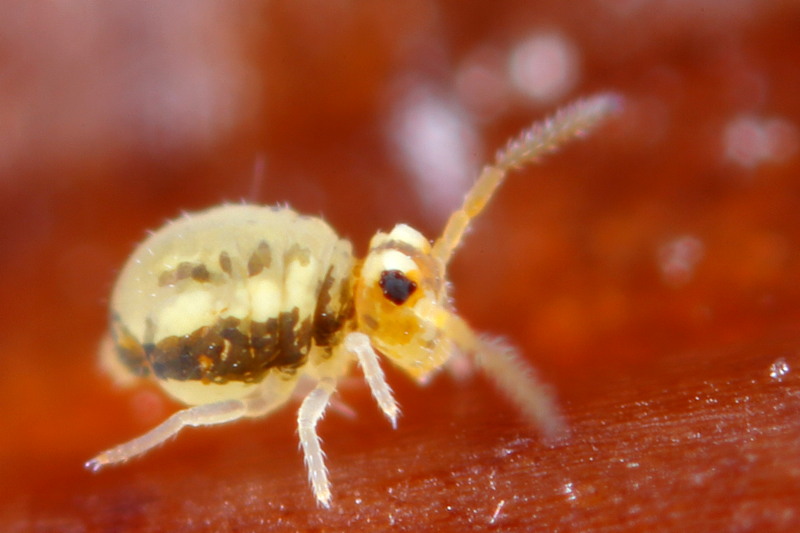
Sminthurinus elegans
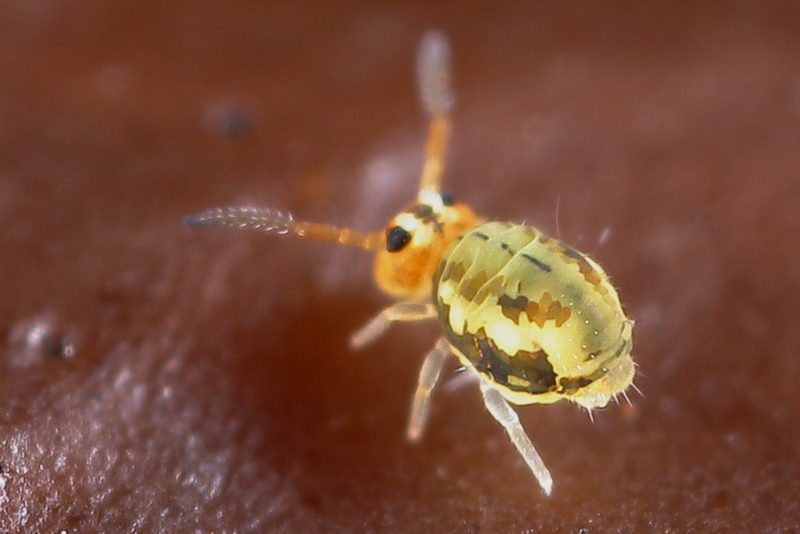
Sminthurinus elegans
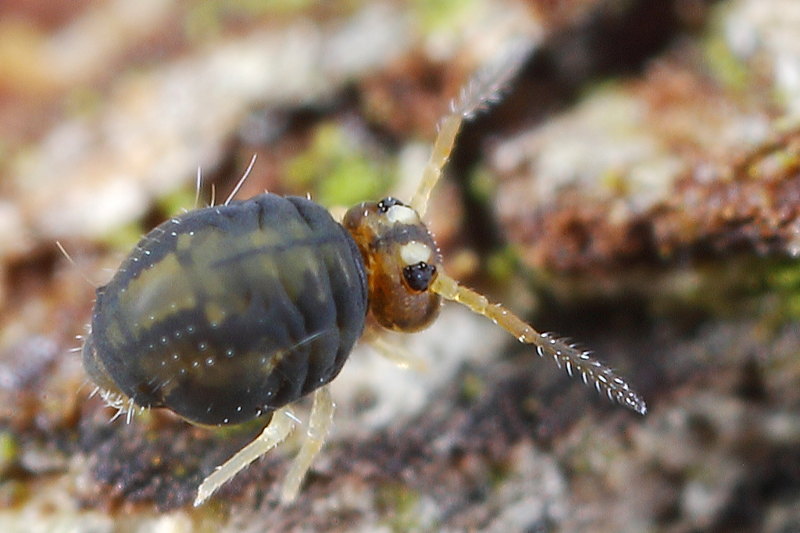
Sminthurinus elegans, very dark form
Sminthurinus lawrencei Gisin, 1963
It was assumed that the black Sminthurinus in The Netherlands would be the species S. niger, however beginning 2018 is also found the species S. alpinus. In Belgium also end 2017 S. concolor. Now the big problem is that these three species look very much alike. It is therefore likely that there will occur more black species in The Netherlands and a part of the earlier observations of S. niger will turn out to be of the species S. alpinus or even S. concolor. They are up to 1 mm long.
By the end of 2021, more is known about the black Sminthurinus species. The different species can even be recognised from a photograph by looking at
the spots between the eyes. The following species are now known in the Netherlands:
Sminthurinus alpinus Gisin, 1953
Sminthurinus aureus (Lubbock, 1862)
Sminthurinus lawrencei Gisin, 1963
Sminthurinus niger (Lubbock, 1868)
A key to distinguishing the black species can be found
here on the website collembola.org
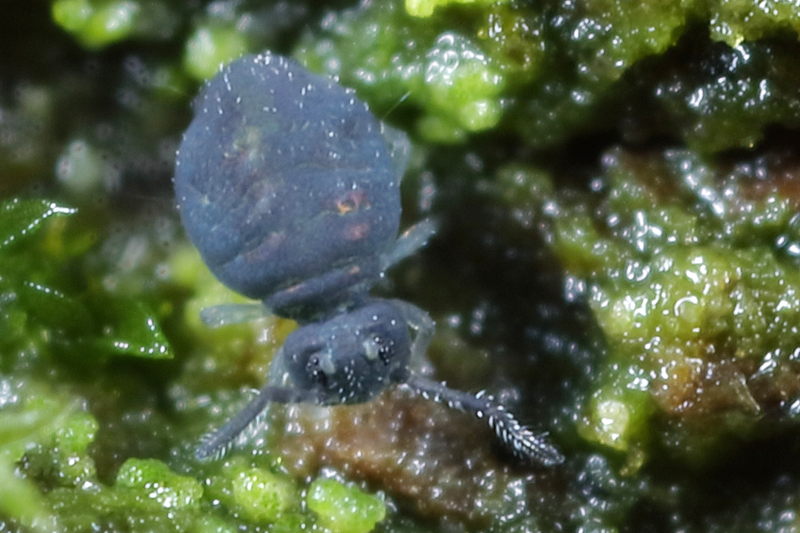
Sminthurinus lawrencei

Sminthurinus lawrencei
Sminthurinus reticulatus Cassagnau P, 1964
Sminthurinus reticulatus looks very similiar to some forms of Sminthurinus aureus, but is distinguished by the sharply defined stripes on the back. Of these stripes, the rear two run together to the abdominal point. This species I have found in my garden on 9-12-2015 and this is the first sighting in the Netherlands.. This species reaches about 1 mm length.
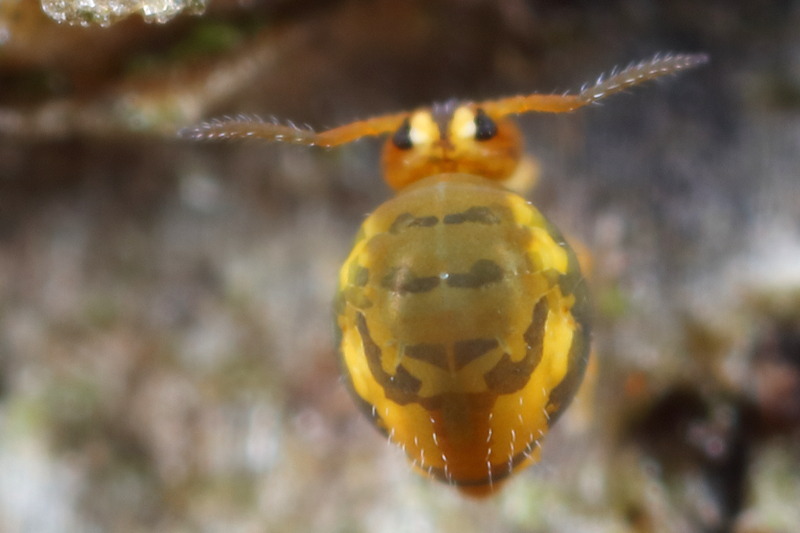
Sminthurinus reticulatus
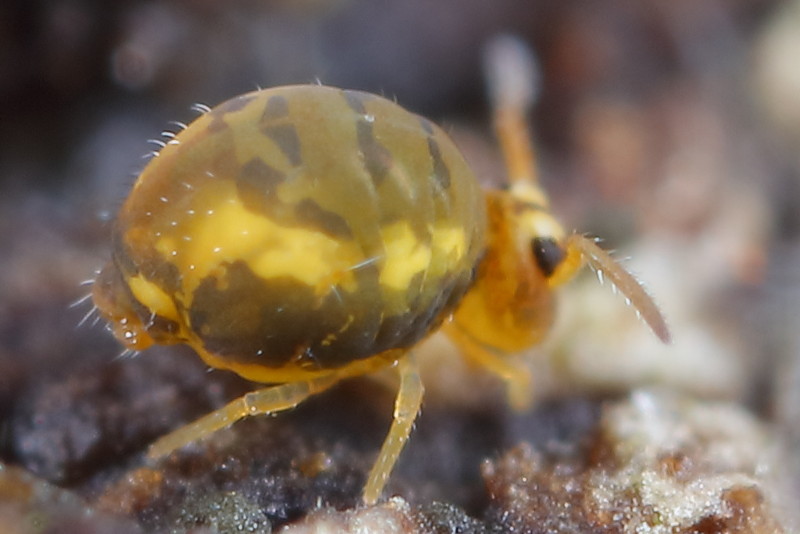
Sminthurinus reticulatus
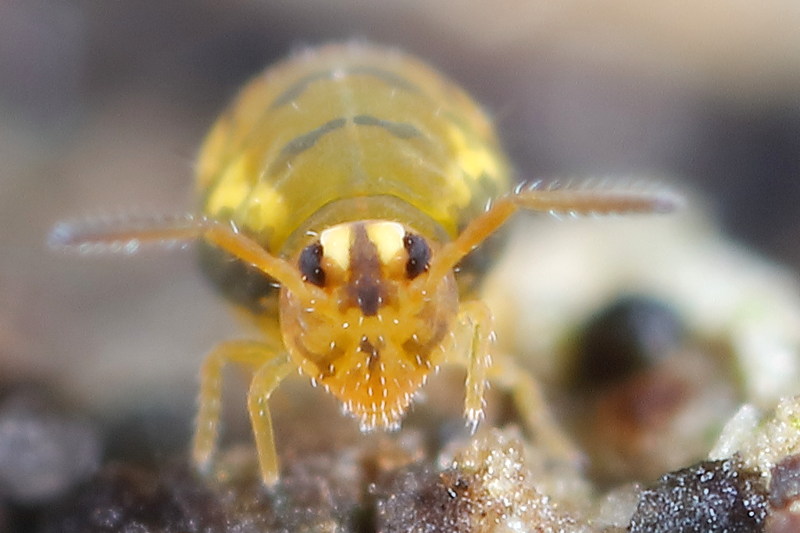
Sminthurinus reticulatus
Sminthurinus trinotatus Axelson, 1905
I see regularly very very small dark springtails with two white spots under the flower pots in and around the greenhouse. They are small, 0.8 mm and difficult to photograph because I see often but a single individual. It's the species Sminthurinus trinotatus according to Frans Janssens. Characteristic are the two white spots on the abdomen and there is a distinct separation between segment five and six, and between the rest of the abdomen.
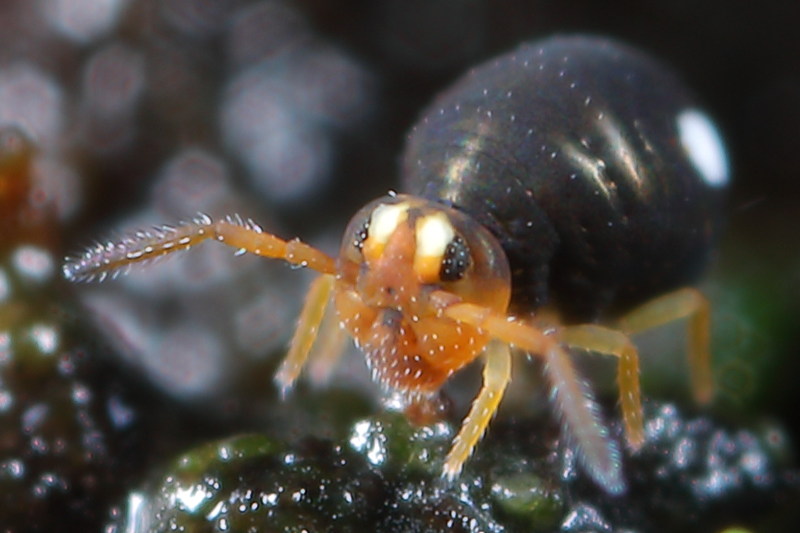
Sminthurinus trinotatus
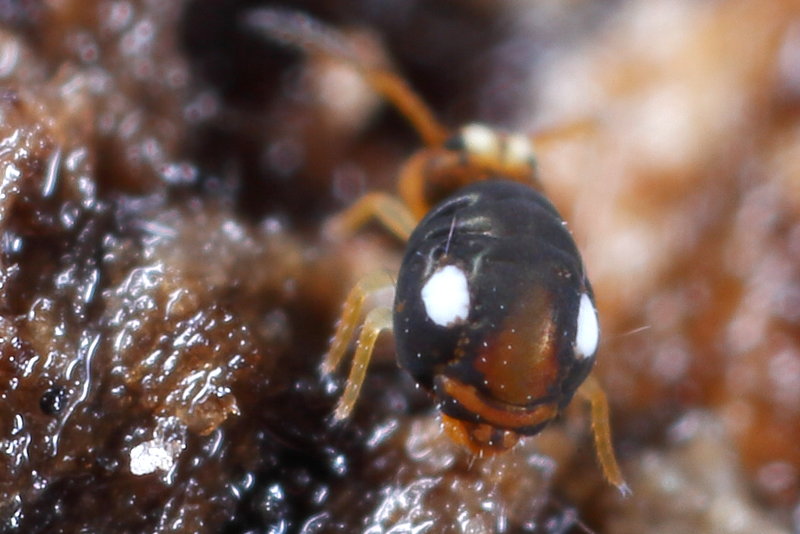
Sminthurinus trinotatus
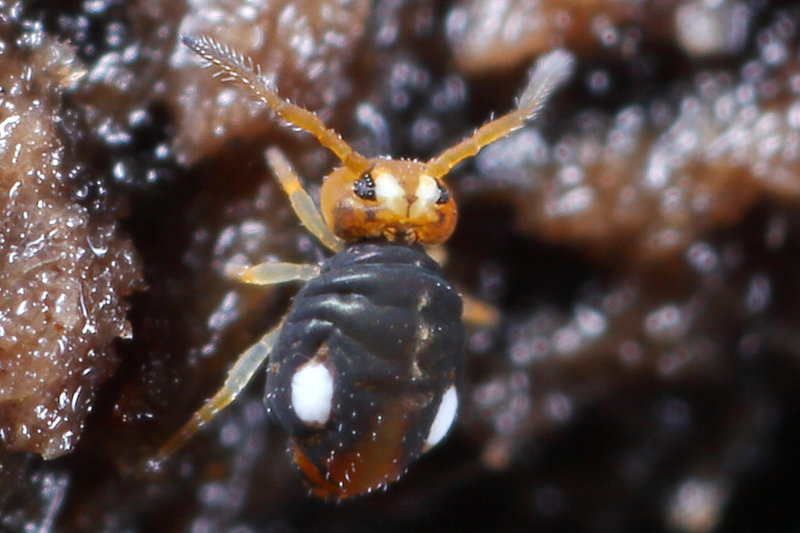
Sminthurinus trinotatus

Sminthurinus trinotatus
Allacma fusca (Linnaeus, 1758)
Allacma fusca is a big, shiny species, up to 3.5 mm long. The color is variable and some forms have got their own name, but it's all the same species. You can find them in many different places. If the humidity is high you see them on trunks and on poles. Furthermore, they sit under stones and on the ground lying material, actually those places where you can always find springtails. In the months of February, March and April I don't see them, the rest of the year though. You see them in large numbers, they are fairly slow and easy to photograph.
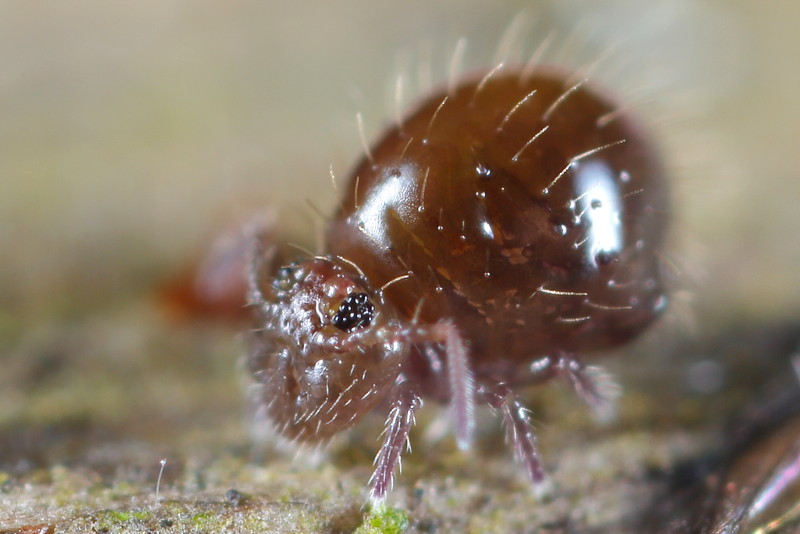
Allacma fusca
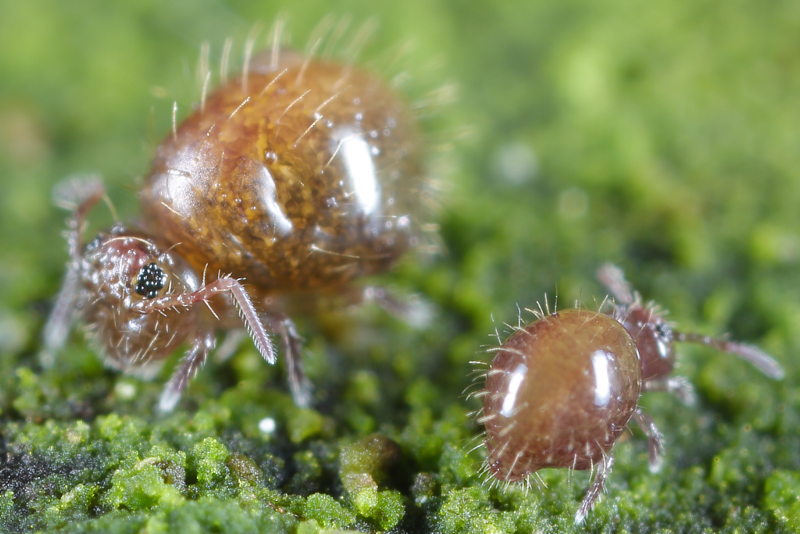
Allacma fusca

Allacma fusca

Allacma fusca forma usignata

Allacma fusca forma pustulata
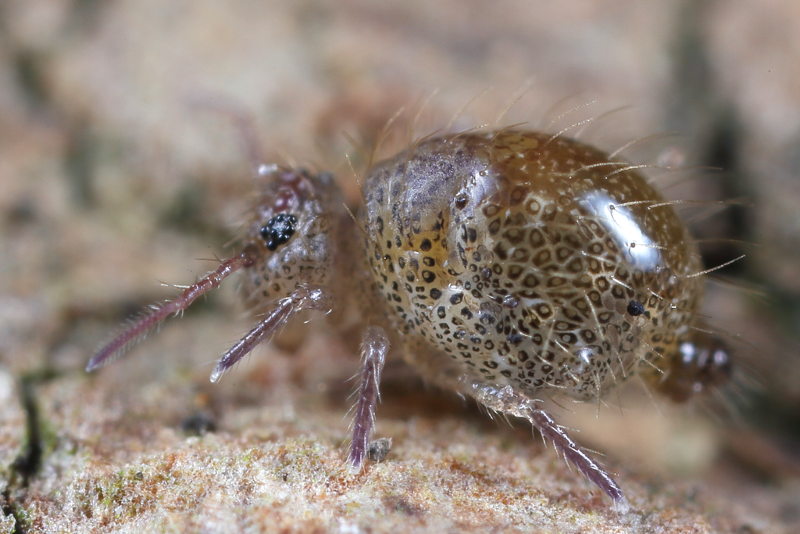
Allacma fusca forma pustulata
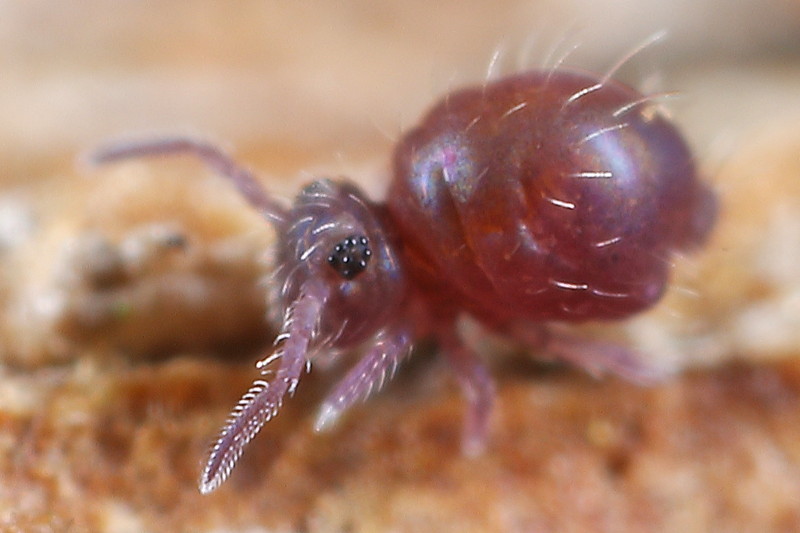
Allacma fusca juvenile
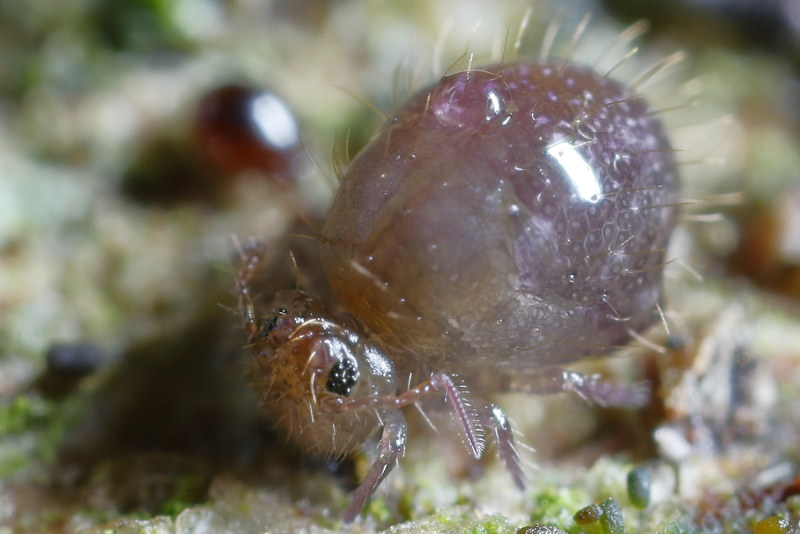
Allacma fusca juvenile
Allacma gallica (Schaft, 1893)
A springtail with the appearance and size of Caprainea marginata but with a yellow head and also much less active is: Allacma gallica.
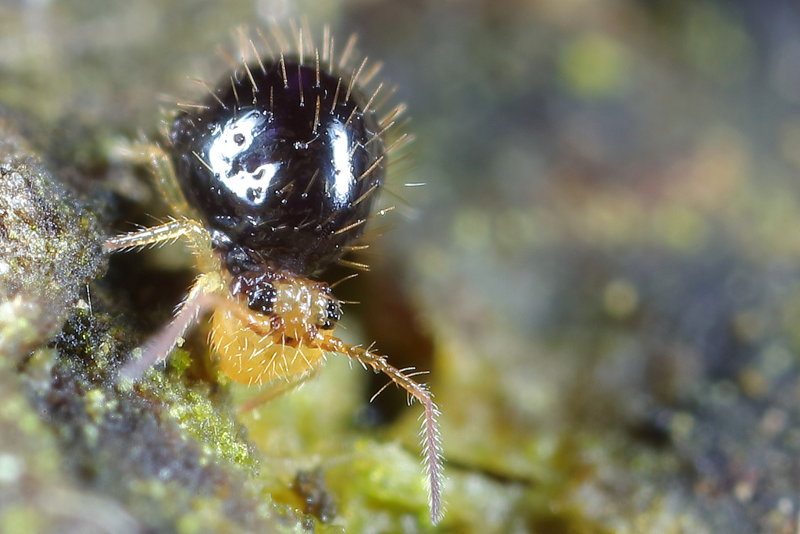
Allacma gallica

Allacma gallica
Caprainea marginata (Schaft, 1893)
A very active springtail I photographed in Bulgaria, it looks like Allacma fusca but that one is bigger, distinctly slow and also has much shorter antennae.

Caprainea marginata forma cinerea
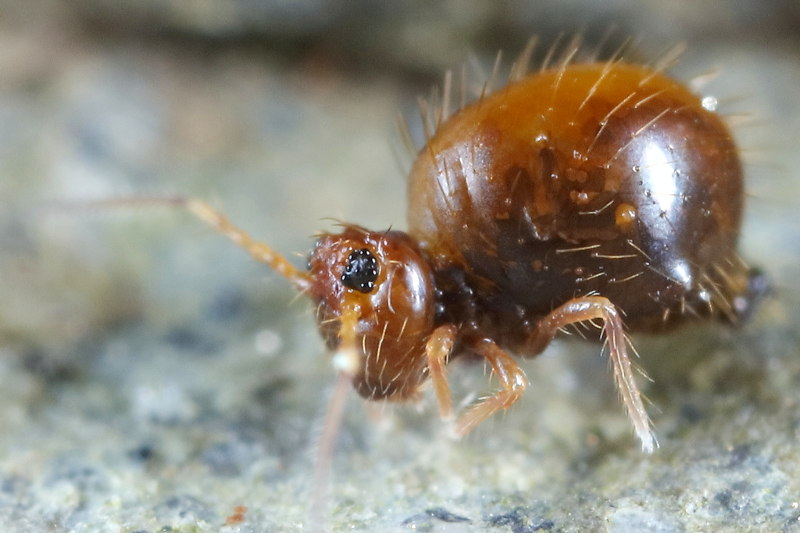
Caprainea marginata forma cinerea
Lipothrix lubbocki (Tullberg, 1872)
Lipothrix lubbocki becomes up to 2 mm long, seems short and sturdy and almost always moves pretty slow. By the rugged spiny hairs on the head you can confuse it with Allacma fusca, but that one is larger, up to 3.5 mm and is much more shiny. The species is known as rare, but I find it regularly throughout the whole country. It is a non notable animal that you usually find under dead wood or between moss.
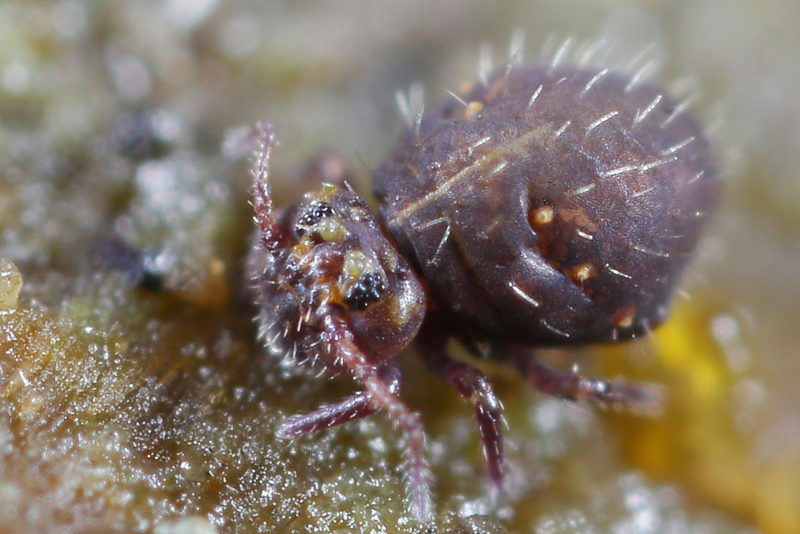
Lipothrix lubbocki
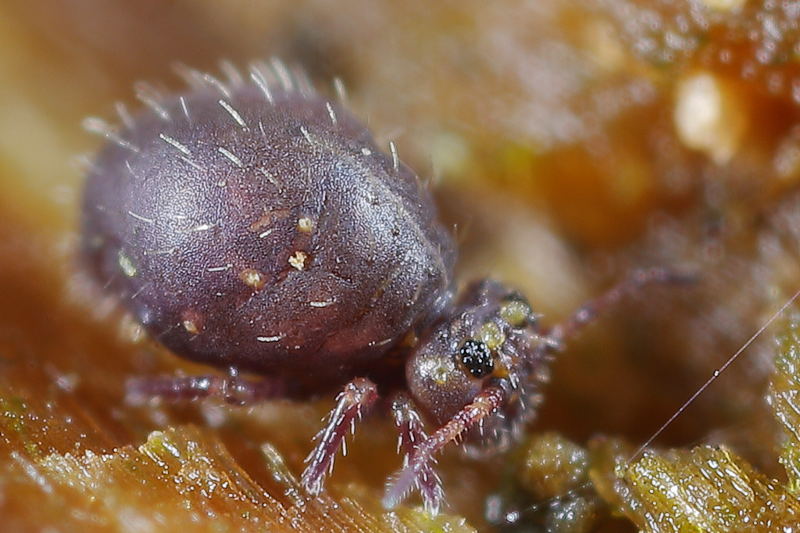
Lipothrix lubbocki
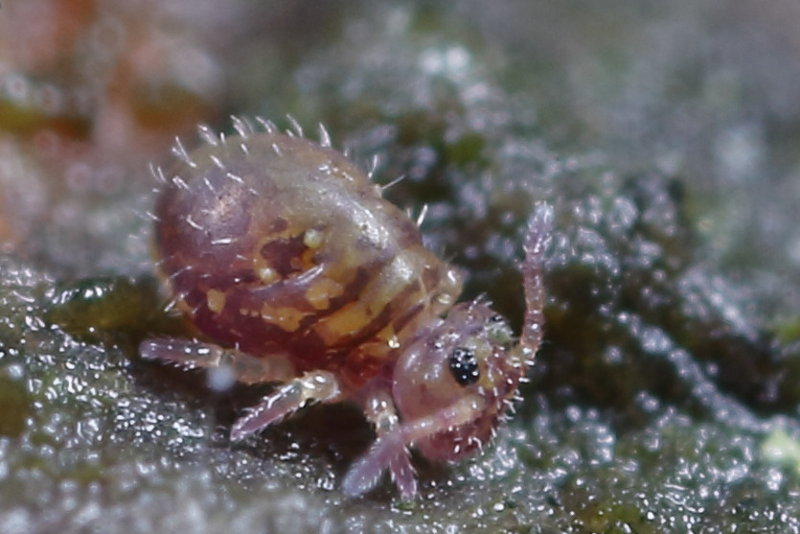
Lipothrix lubbocki, juvenile
Sminthurus leucomelanus Nayrolles, P, 1995
Not all species of springtails you will find under wood and stones, some species live on the leaves of plants, and Sminthurus leucomelanus is one of them. This animal lives on the very dry small grasses on heaths. As a result, I had great difficulty to find the animal, only after searching three times in an area from where he was reported delivered the desired result, finally photos of this species.
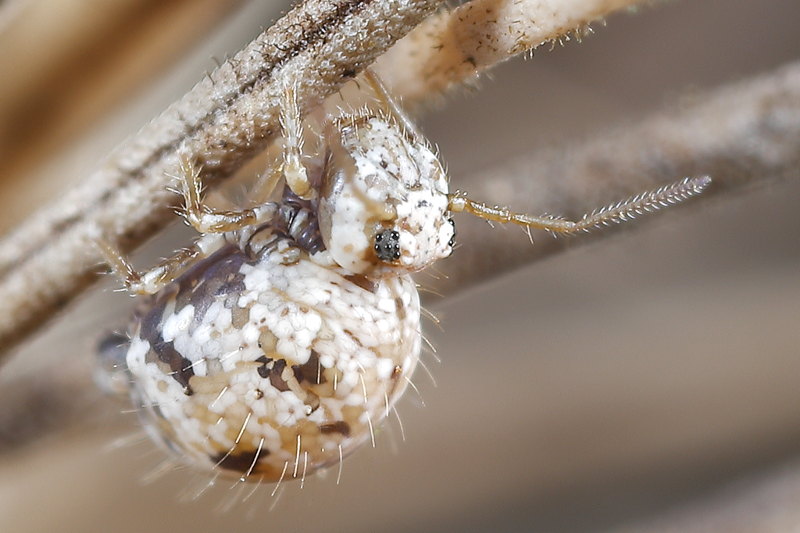
Sminthurus leucomelanus
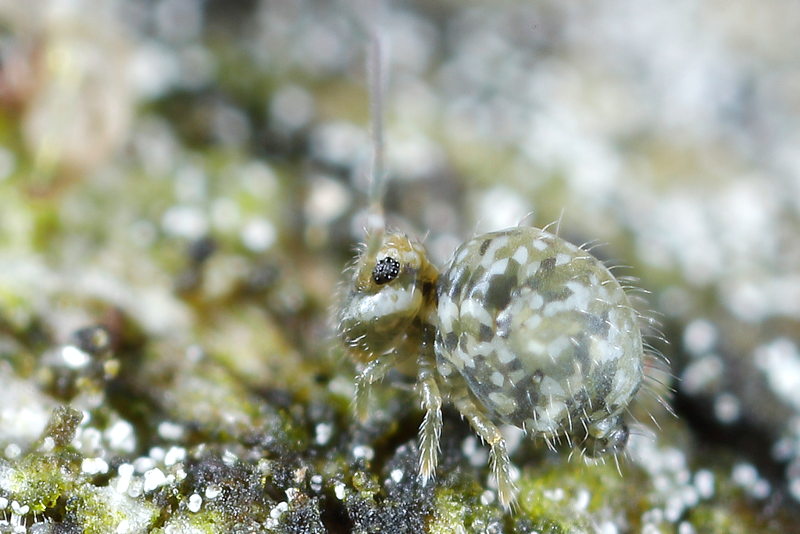
Sminthurus leucomelanus
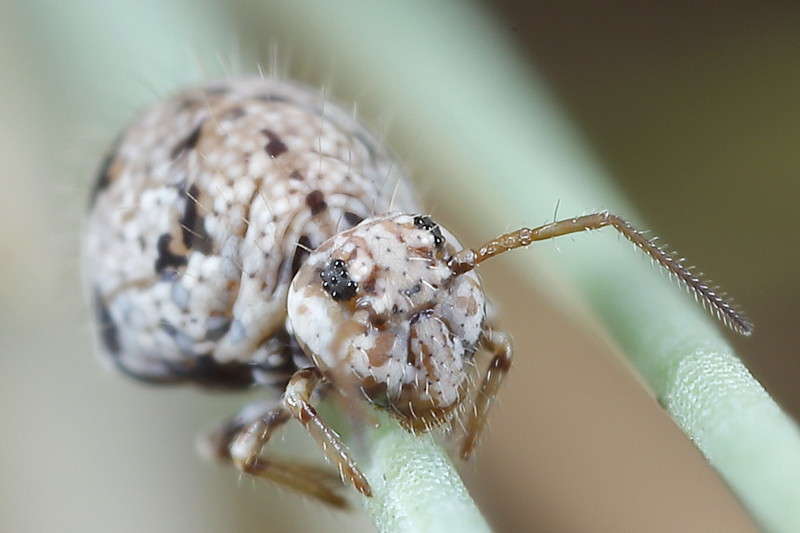
Sminthurus leucomelanus

Sminthurus leucomelanus
Sminthurus nigromaculatus Tullberg, 1871
On the heath I find a species of springtail on which opinions are divided.
www.collembola.org caled it a synonym from the subspecies of S. viridis annulatus Folsom, 1899
Syn.: Smynthurus(sic) viridis ssp. nigromaculata Tullberg, 1871
The EIS workgroup Soil fauna in the Netherlands regards it as a good species, Sminthurus nigromaculatus,
with the motivation that the two species never occur together, S. viridis can be found on richer, more disturbed
locations (fertilised meadows), while S. nigromaculatus can be found on less disturbed locations (heath-areas).
In the key from Bretfeld and from Fjellberg both are treated as separate species.
The difference is in the number of black dots on the rear tip of the body, according to Frans Janssens:
A short overview (dorsal spots on small abdomen = abd. 5 + 6):
1 spot: Sminthurus viridis viridis (= forma principalis)
2 spots: Sminthurus viridis cinereoviridis
3 spots: Sminthurus viridis nigromaculatus (= ecovariant of relatively cold incubation period)

Sminthurus viridis
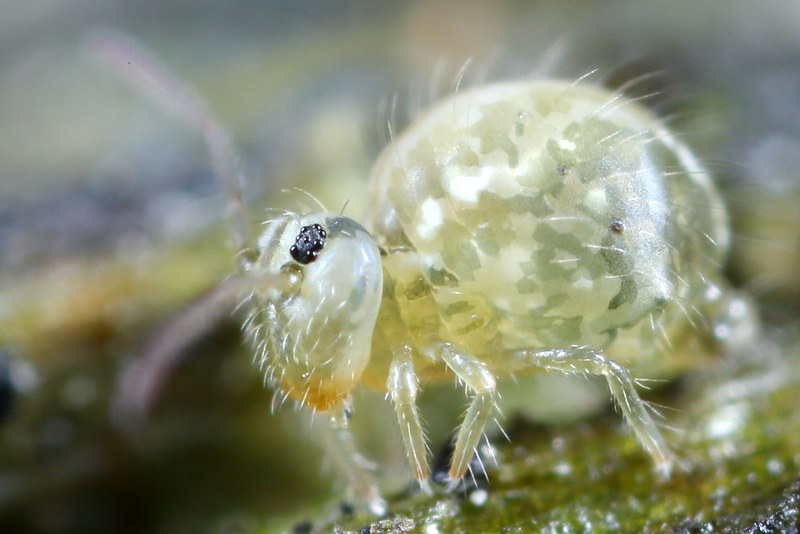
Sminthurus viridis
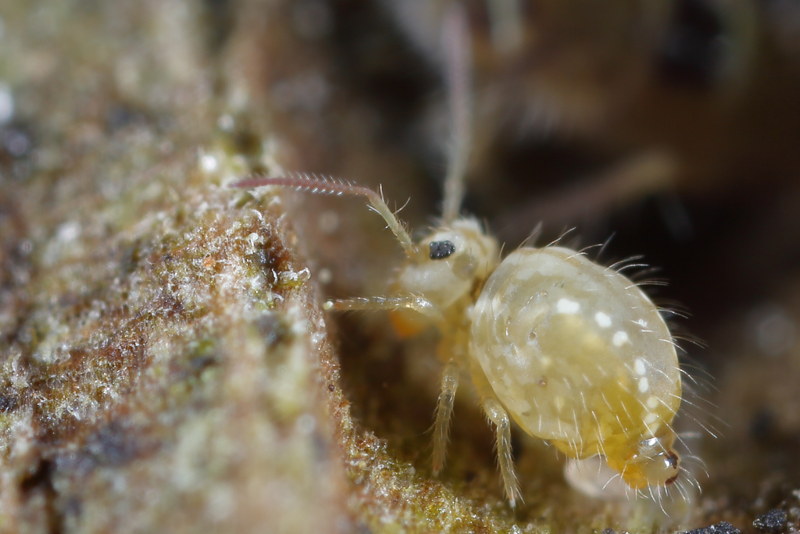
Sminthurus viridis
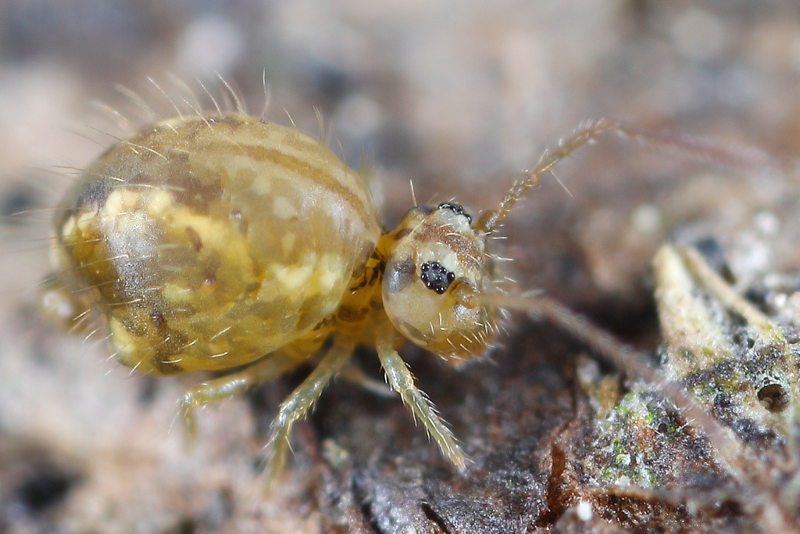
Sminthurus viridis
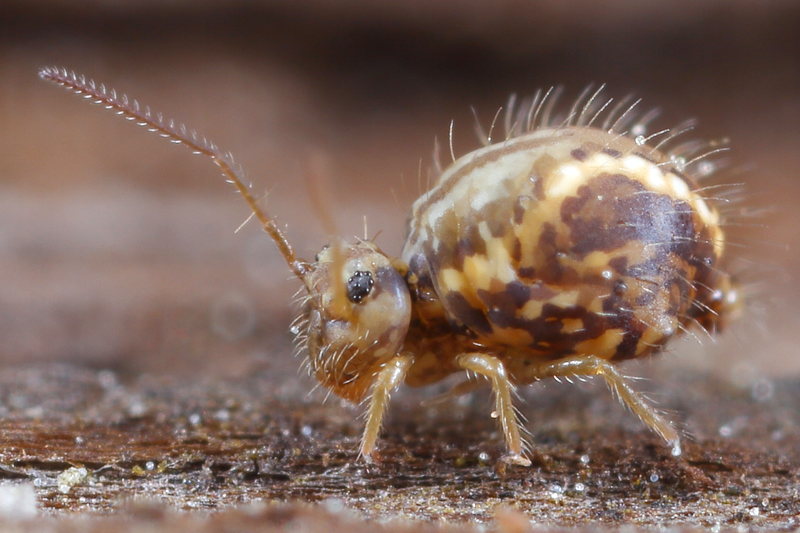
Sminthurus viridis
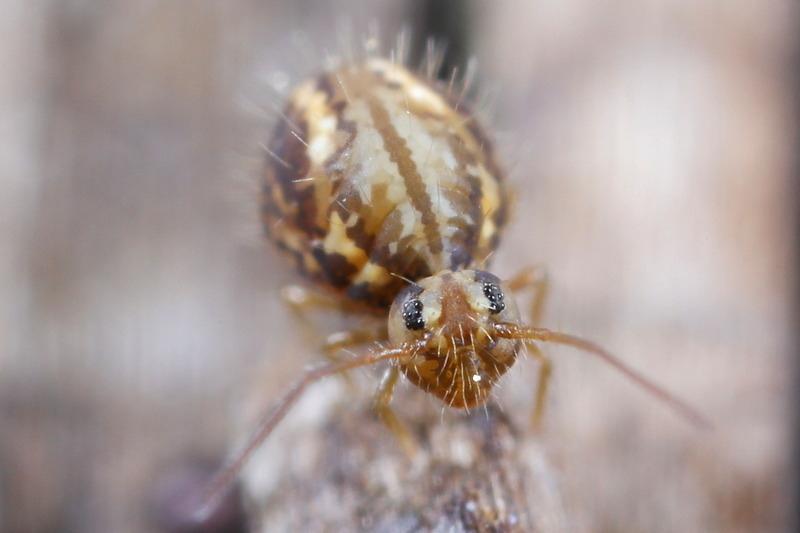
Sminthurus viridis
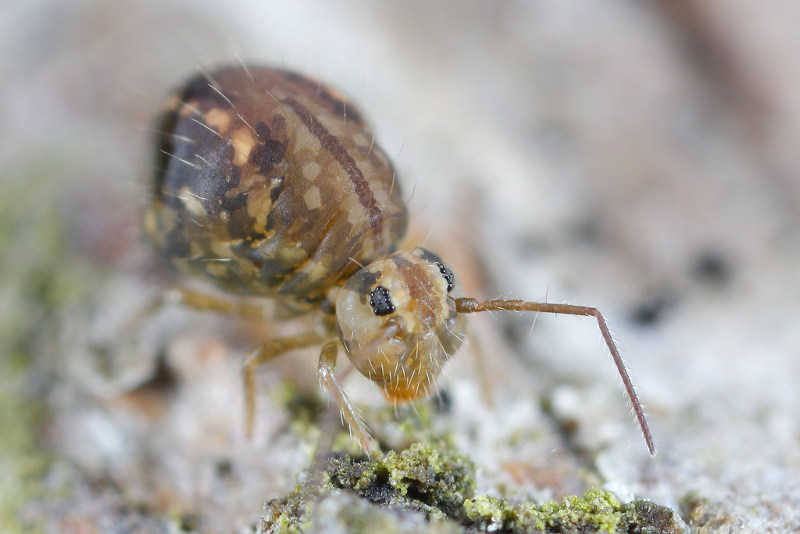
Sminthurus viridis
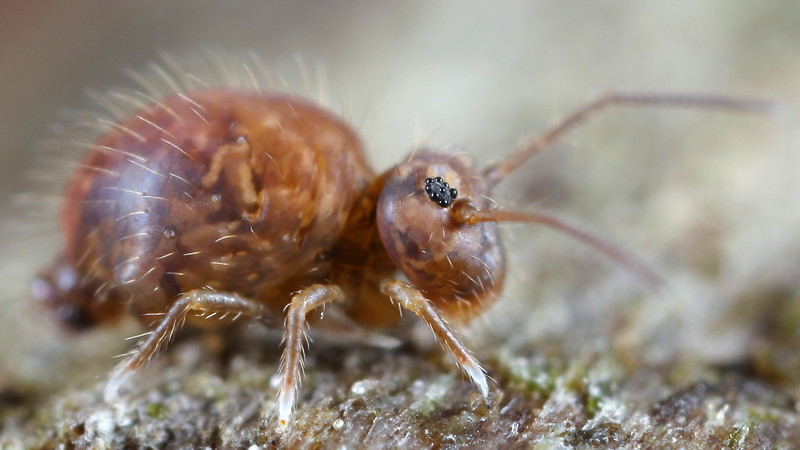
Sminthurus viridis
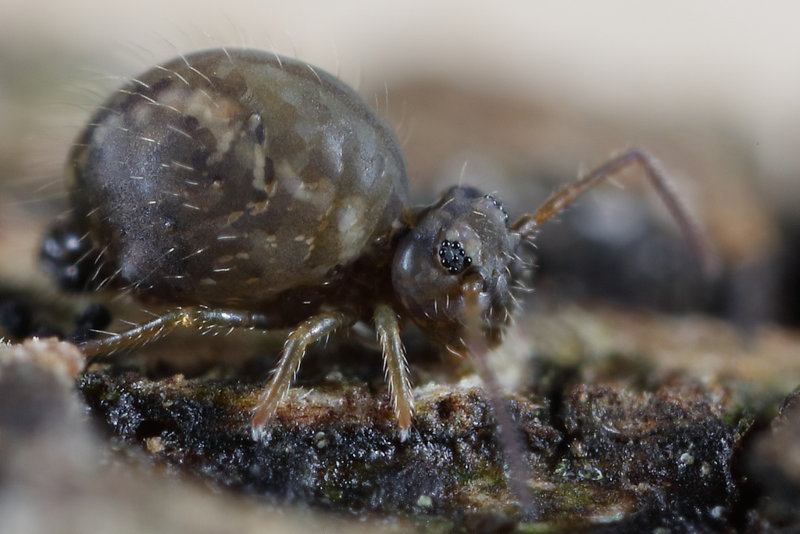
Sminthurus viridis
Sminthurus viridis Linnaeus, 1758
14-05-2010 The number of species of springtails in the garden is much bigger than I ever expected. On one of the slides from 2007 is somewhere an indistinct green globular springtail which I thought it could be Sminthurus viridis. When working in the garden I see a green springtail jumping and yes, it is. In August, September and October 2010, many more specimens of this species were up in a cement tub full of water. So you can say, they are not rare in my garden. This species will do sometimes damage to planted crops such as alfalfa. It was accidentally introduced in Australia and is there a pest sometimes.
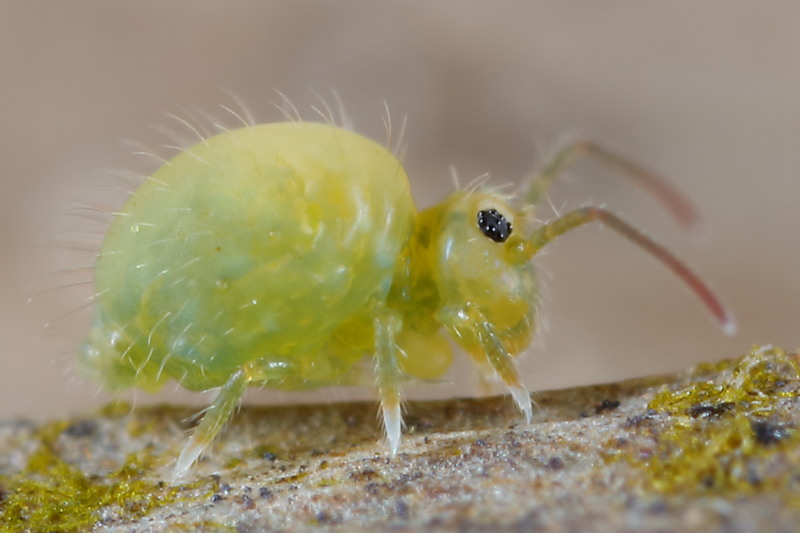
Sminthurus viridis
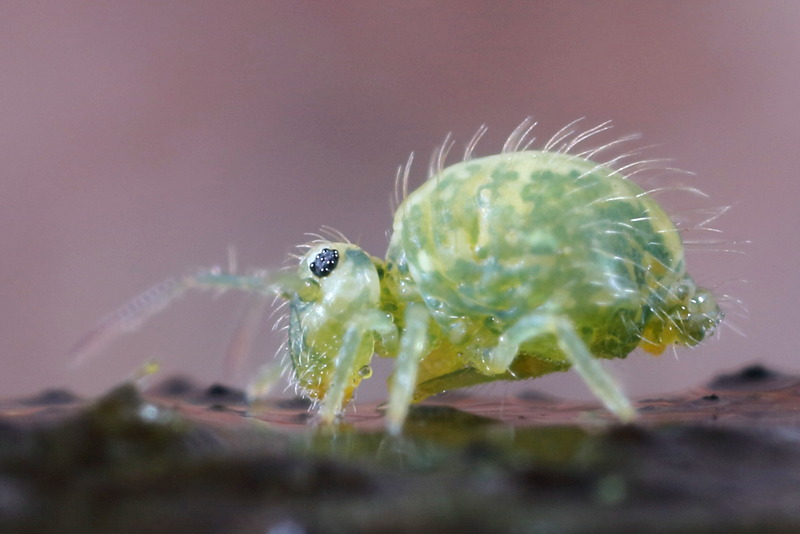
Sminthurus viridis
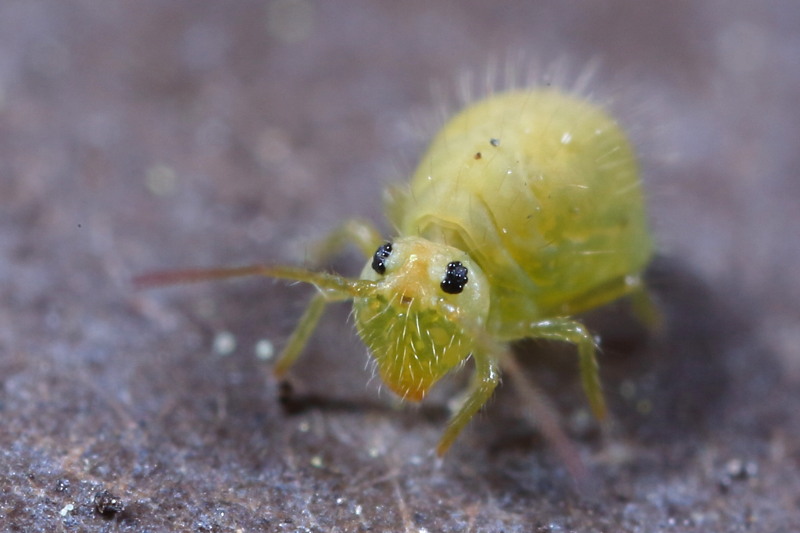
Sminthurus viridis
Sminthurides aquaticus (Bourlet, 1842)
A tiny round springtail is Sminthurides aquaticus. I find this springtail on floating leaves on the pond. Actually I am getting shots of the now common species Isotomurus, when he suddenly appears before the lens. Here a picture where it is on together with Isotomurus palustris so you can compare the size.

Sminthurides aquaticus and I.palustris
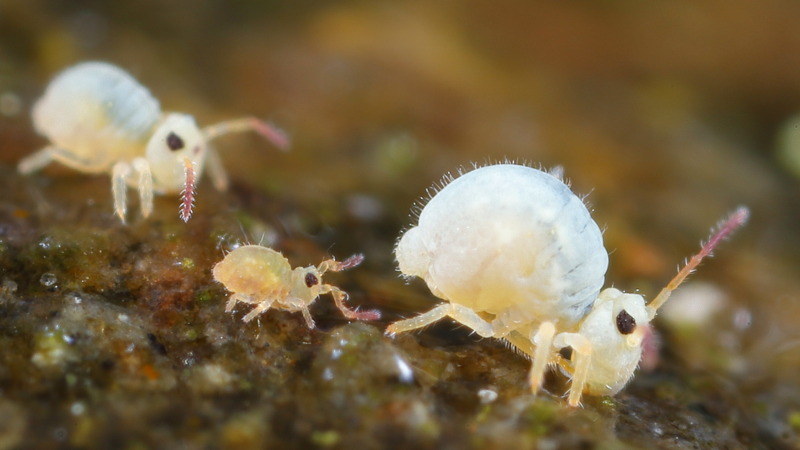
Sminthurides aquaticus
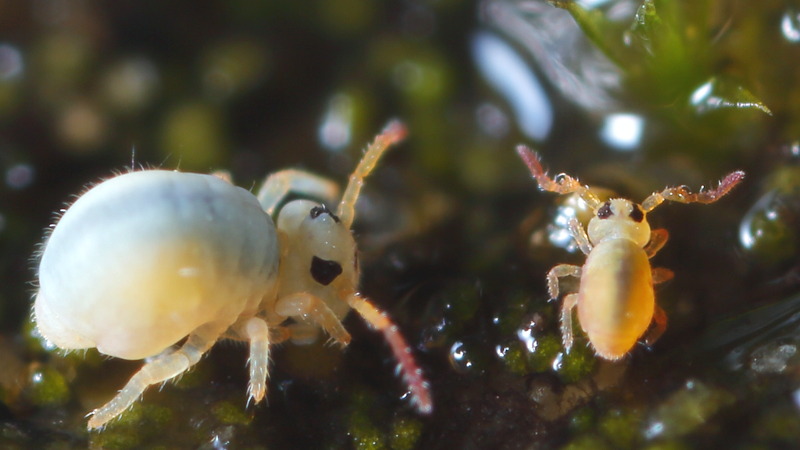
Sminthurides aquaticus, right the male
A few shots of Sminthurides aquaticus, after some searching it prove by no means rare they are on many stones at the edge of the pond. They are very small and that is probably the reason that I've never seen them before. The males go and stand in front of the females and grab them with the antennae. As they walked around like that, the male puts down a sperm package that is absorbed by the female. The males are often opposed. The reason I could not find, but I can imagine that it is a kind of rival fight. On the picture you see the little male with his corkscrew-shaped antennae.
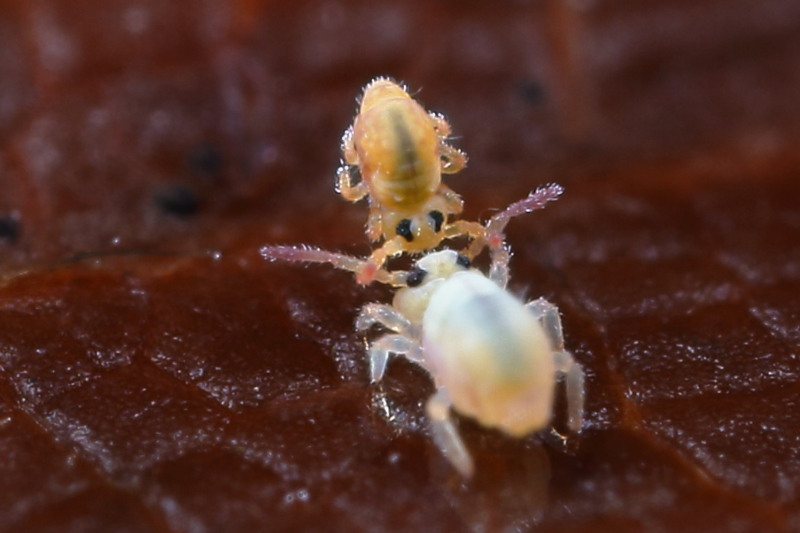
Sminthurides aquaticus female carries male
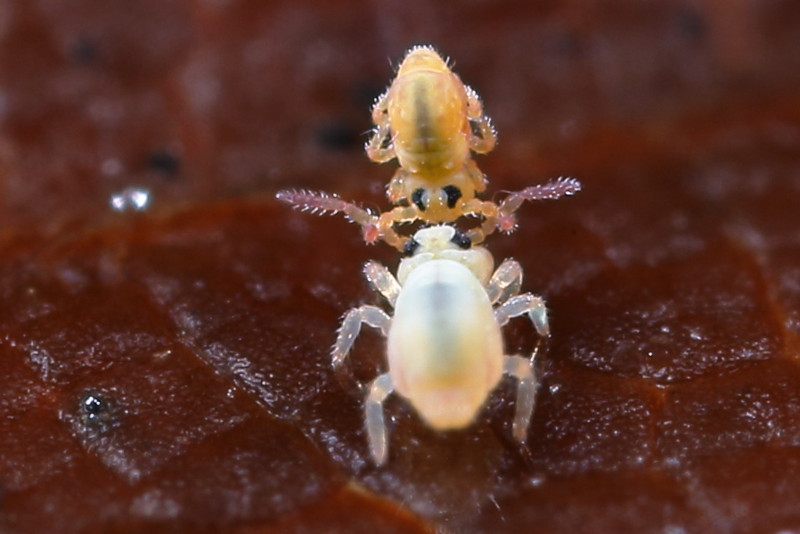
Sminthurides aquaticus female carries male
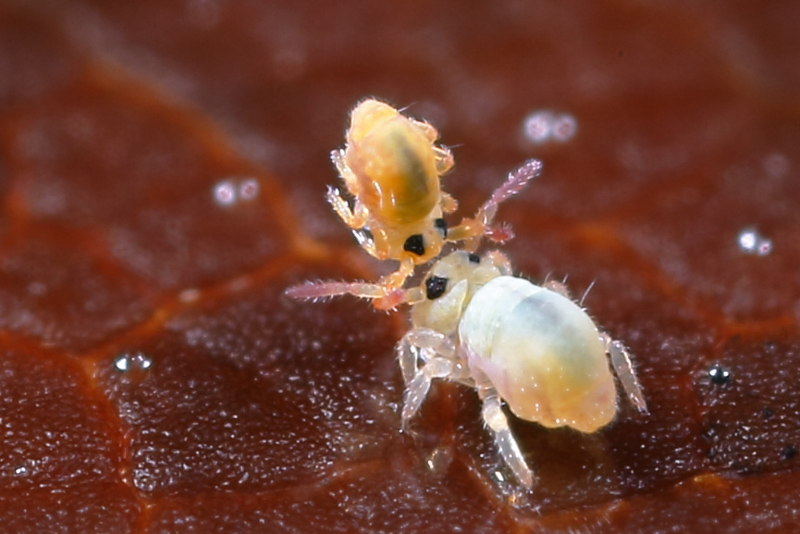
Sminthurides aquaticus female carries male
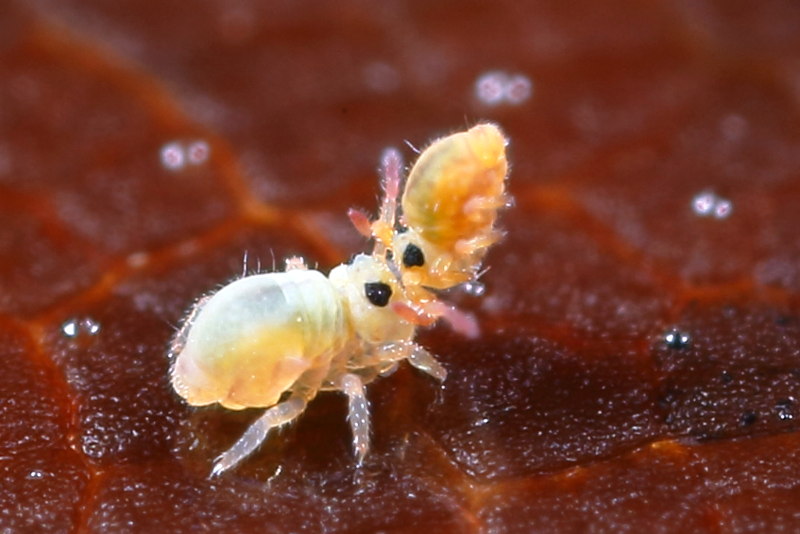
Sminthurides aquaticus female carries male

Sminthurides aquaticus
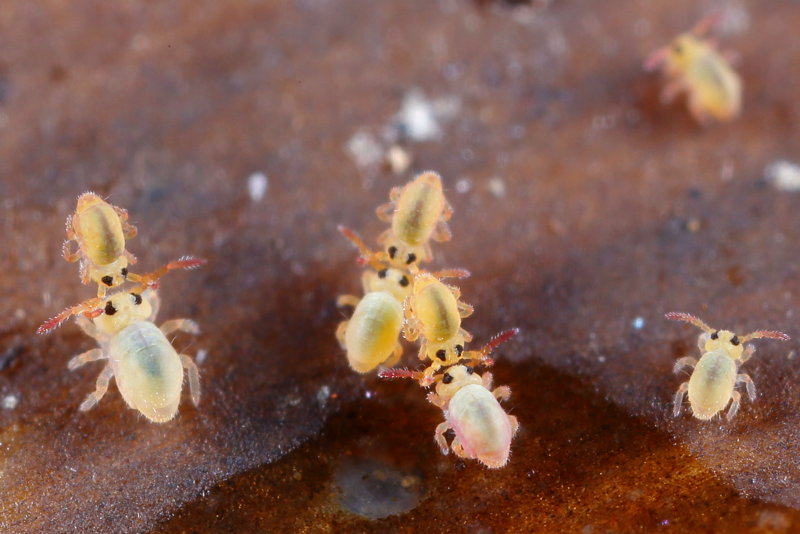
Sminthurides aquaticus
This springtail also exist in some colour forms, one of these I see on the pond behind my house. This form is called: Sminthurides aquaticus var. levanderi. Typical are the black socks and the dark band between the eyes.
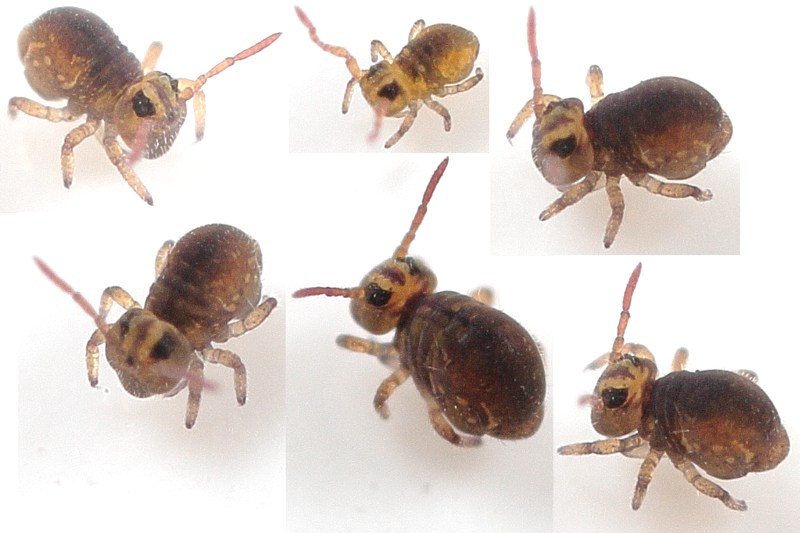
Sminthurides aquaticus var. levanderi
Sminthurides cruciatus (Axelson, 1905)
In Zuid-Limburg on 2017 september 28, I find a springtail that I dont know.
After looking on the site Collembola.org I think it is Sminthurides cruciatus, what is confirmed later by Frans Janssens.
It appears to be the first sighting in The Netherlands.
On a small portion of the shore of a large pond next to the Maas, are large numbers on the wet clay, so close to the water.
Young animals are very light in color, older very dark, the variability in color and drawing is huge.
Adult animals are about 0.6 mm long.
There is something strange with this species, the courtship you only see at the smaller animals. You don't see the large females concerned with males.
The behavior of the large animals is also completely different from the small, the large jump away much earlier than the small. My first impression
was that it were two different species, but when viewing the pictures on the PC you will see that it is the same species.
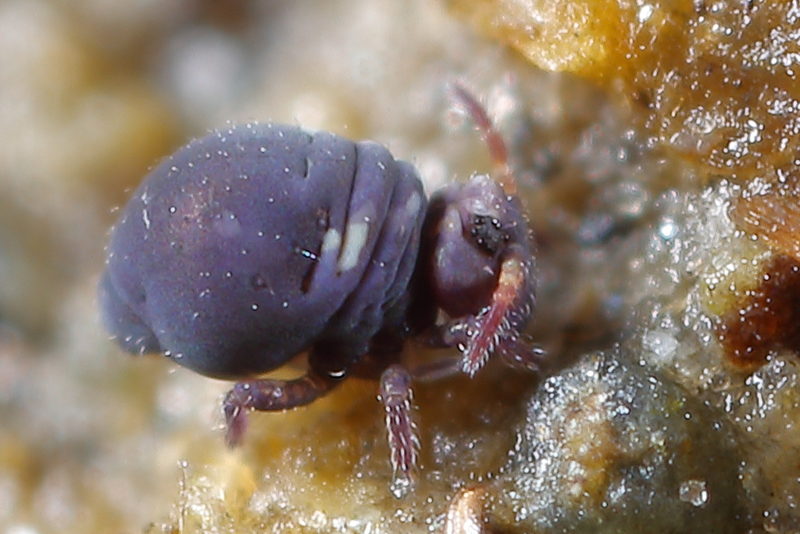
Sminthurides cruciatus
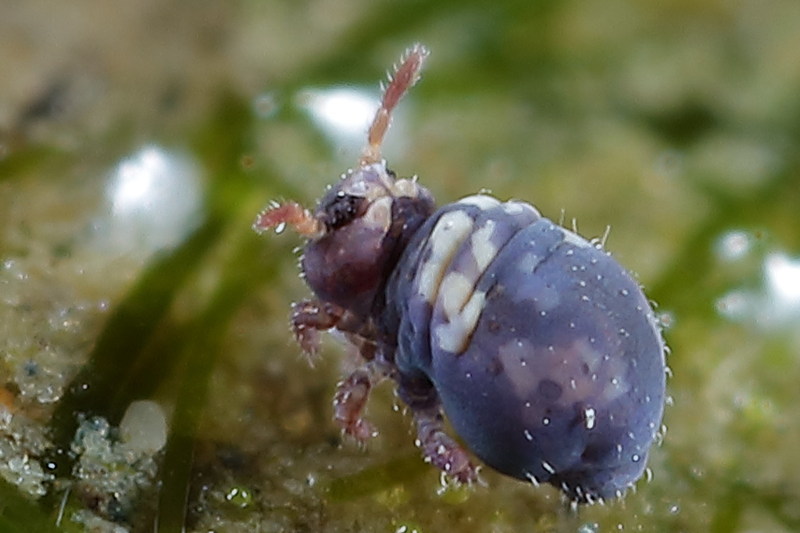
Sminthurides cruciatus
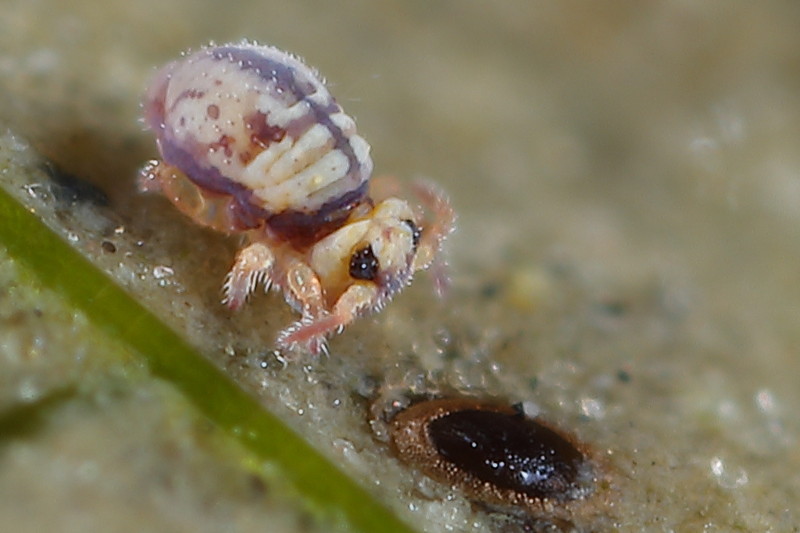
Sminthurides cruciatus
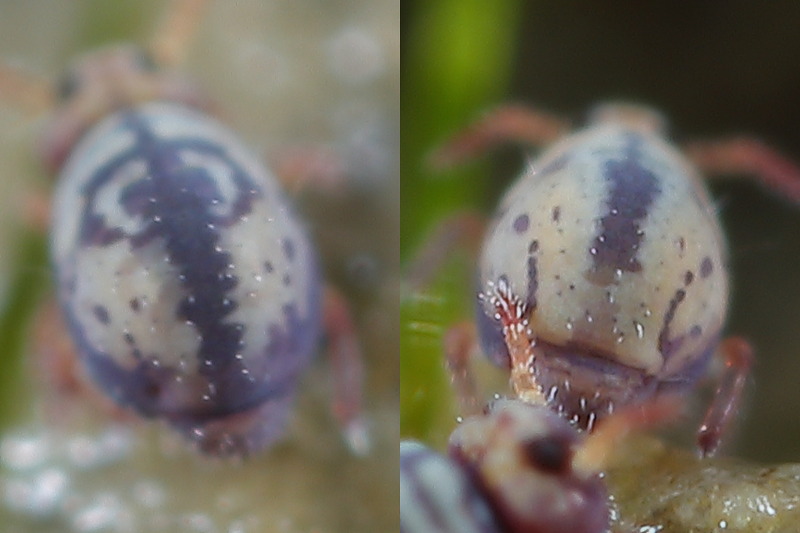
Sminthurides cruciatus

Sminthurides cruciatus, ♂

Sminthurides cruciatus
Sminthurides malmgreni (Tullberg, 1876)
A small, coloured springtail is Sminthurides malmgreni. This animal I found for the first time on a pond in my garden, the last time I see it more often in a dry stream. You will find them always at the water, often on sticks that are half in the water. Females are about 0.6 mm long and the males are half as long and have the same type of antennae as the previous species.

Sminthurides malmgreni, ♀
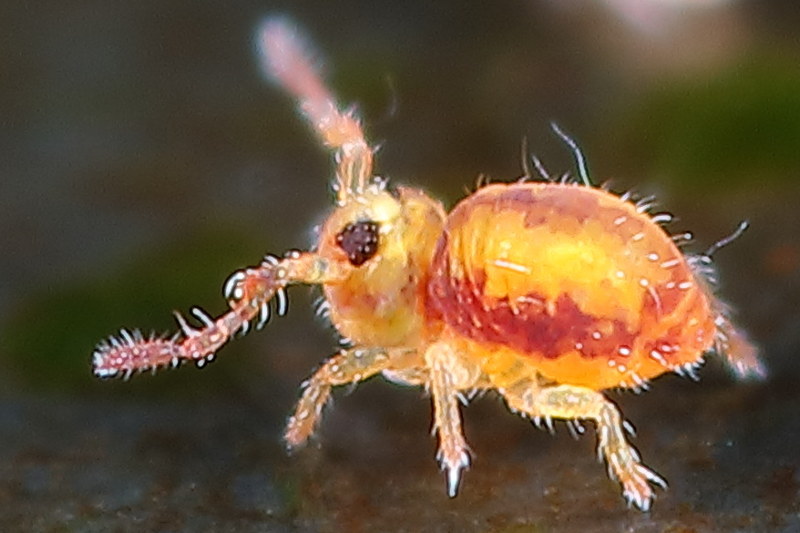
Sminthurides malmgreni, ♂
Sminthurides parvulus (Krausbauer, 1898)
At the side of a pond in a forrest near Noord Sleen I vind a springtail that most resembles Sminthurides schoetti only the markings on the back are absent. It turns out to be Sminthurides parvulus. The first sighting in The Netherlands on August 25, 2016.. It belongs to the realy small springtails. The animal on the pictures is a female, males have twisted antennae.

Sminthurides parvulus

Sminthurides parvulus
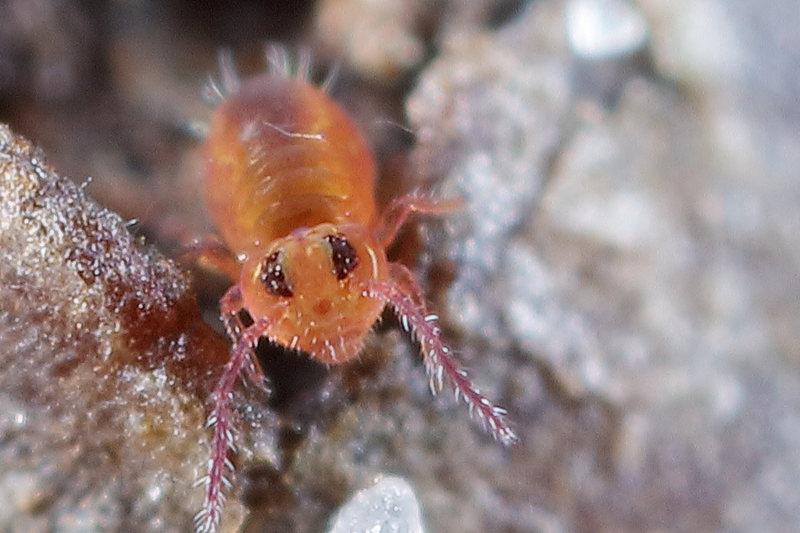
Sminthurides parvulus
Sminthurides penicillifer
In 2014 I discover this species in Germany, about 15 km over the border near Zwartemeer. In 2017, I find it on the banks of a large pond along the river Maas in Zuid-Limburg. The females have a light edge along the body, which sometimes glows blue in the Sun.
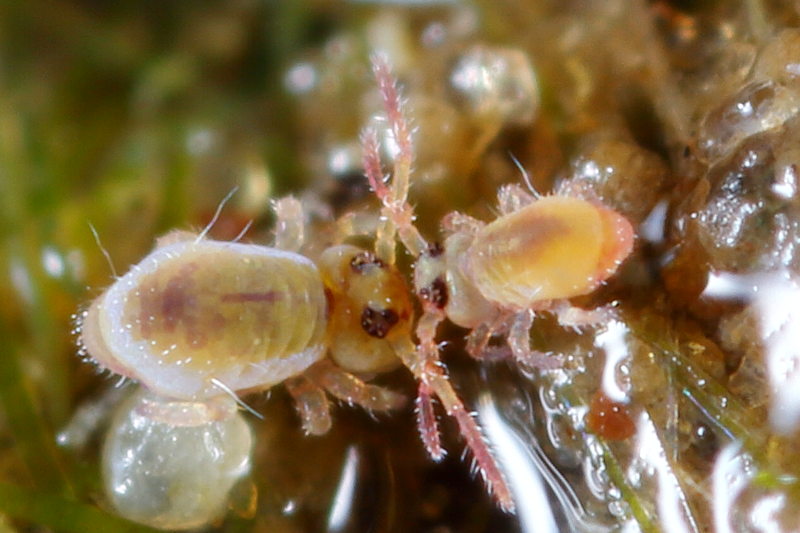
Sminthurides penicillifer, mating ritual

Sminthurides penicillifer
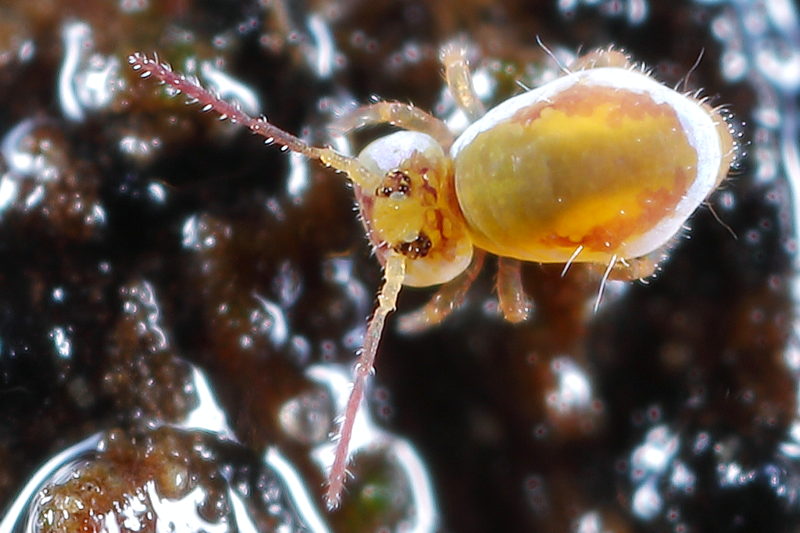
Sminthurides penicillifer
Sminthurides schoetti Axelson, 1903
Even smaller than Stenacidia violacea is Sminthurides schoetti, females are 0.5 mm males 0.3 mm. They look very similar, the differences are in the fourth antennal segment that consist of four pieces in the female S. schoetti but you understand that this is only visible at a huge magnification. Another problem is that they often occur together. But S. schoetti has a lichte back stripe with cross bars. This bright stripe has S. violacea sometimes, but the cross bars are missing.
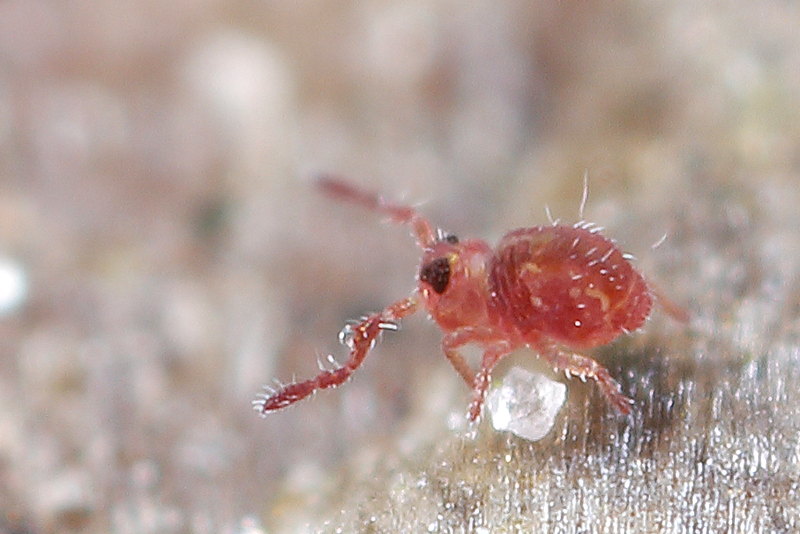
Sminthurides schoetti ♂
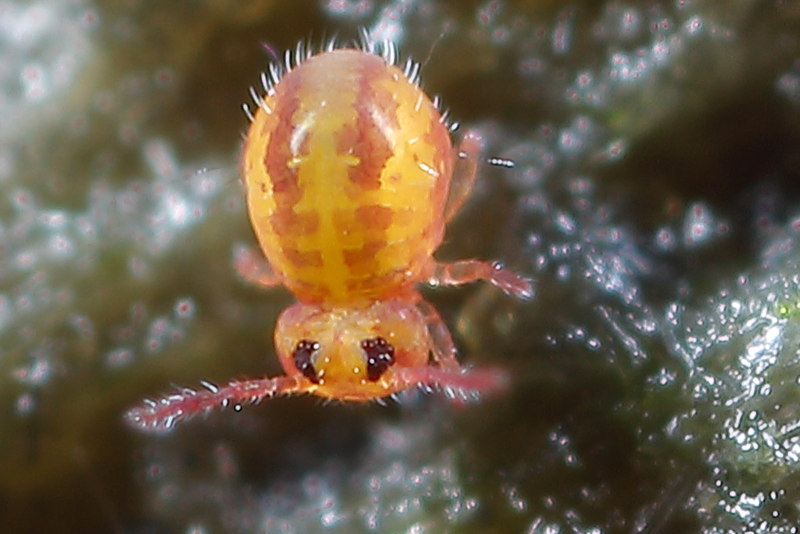
Sminthurides schoetti ♀
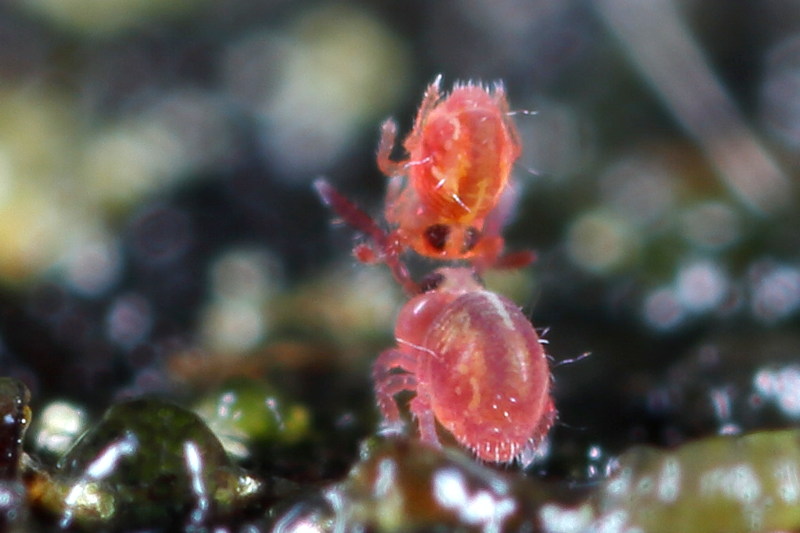
Sminthurides schoetti, courtship

Sminthurides schoetti, courtship
Sphaeridia pumilis (Krausbauer, 1898)
The animals of this family are small, at the kind Sphaeridia pumilis
the females are up to 0.5 mm males up to 0.25 mm long.
On the females there often is on the back behind the head a distinctive drawing,
which you can also see on the photographed animals, the reddisch, a kind of button behind the head.
The color of the species is variable.
Males have a kind of corkscrew antenna, they can hold the antenna of the female during courtship.
This species has a real mating what at most springtail species does not occur.
At the very bottom a picture of two mating animals.

Sphaeridia pumilis, ♀♀

Sphaeridia pumilis, ♀♀

Sphaeridia pumilis, ♂
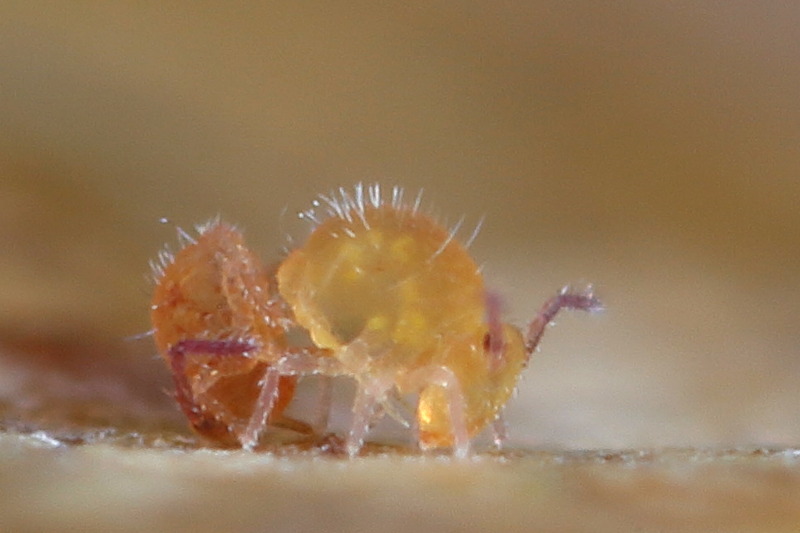
Sphaeridia pumilis, mating
Stenacidia violacea (Reuter, 1881)
Stenacidia violacea is a small springtail, females are 0.7 mm males 0.5 mm. The animals of the photos I have found on a heath site under a loose branch on the ground. Men are conspicuous by the box shaped abdomen with two rows of large setae (hairs) on the back and lots of long setae on the legs. The antennae of the males are, like all species of this group, transformed into holding devices to keep the female in courtship.

Stenacidia violacea, ♂

Stenacidia violacea, ♀♀
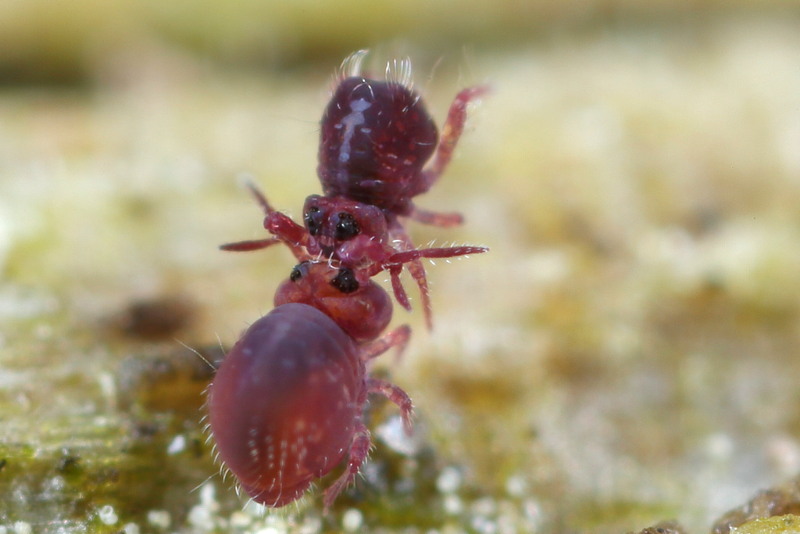
Stenacidia violacea, courtship
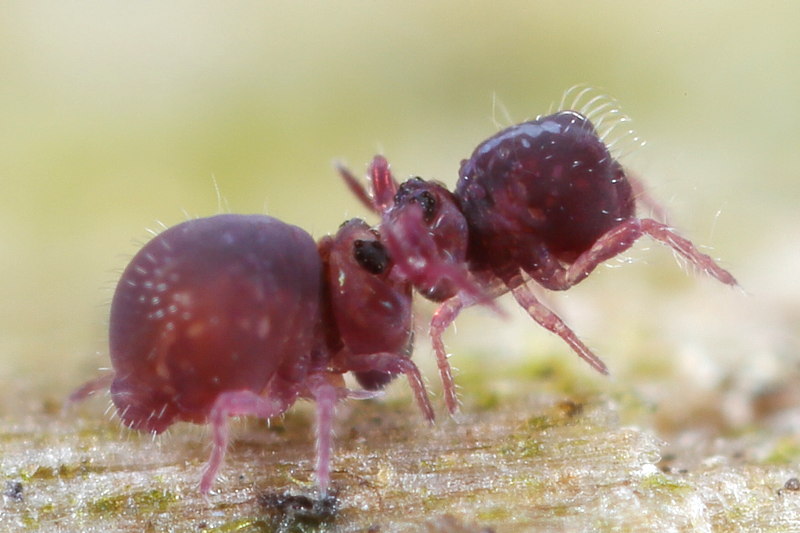
Stenacidia violacea, courtship
Overview species:
- Order: NEELIPLEONA Massoud, 1971
- Family: Neelidae Folsom, 1896
- Megalothorax minimus Willem, 1900
- Order: SYMPHYPLEONA Börner, 1901
- Family: Arrhopalitidae Stach, 1956
- Pygmarrhopalites bifidus (Stach, J, 1945)
- Family: Bourletiellidae Börner, 1913
- Bourletiella arvalis (Fitch, 1863)
- Bourletiella hortensis (Fitch, 1863)
- Bourletiella viridescens Stach, 1920
- Cassagnaudiella pruinosa (Tullberg, 1871)
- Deuterosminthurus bicinctus (Koch, 1840)
- Deuterosminthurus pallipes (Bourlet, 1843)
- Fasciosminthurus quinquefasciatus (Krausbauer, 1898)
- Heterosminthurus claviger (Gisin, 1958)
- Heterosminthurus insignis (Reuter, 1876)
- Heterosminthurus novemlineatus (Tullberg, 1871)
- Family: Dicyrtomidae Börner, 1906
- Jordanathrix sp. 4
- Dicyrtoma dorsosignata Stach, 1924
- Dicyrtoma fusca (Lubbock, 1873)
- Dicyrtomina minuta (O. Fabricius, 1783)
- Dicyrtomina ornata (Nicolet, 1842)
- Dicyrtomina saundersi (Lubbock, 1862)
- Family: Katiannidae Börner, 1913
- Gisinianus flammeolus (Gisin, 1957)
- Katianna schotti (Womersley, 1933)
- Sminthurinus alpinus Gisin, 1953
- Sminthurinus aureus (Lubbock, 1862)
- Sminthurinus concolor (Meinert, 1896) Stach, 1956
- Sminthurinus domesticus (Gisin, 1963)
- Sminthurinus elegans (Fitch, 1863)
- Sminthurinus lawrencei Gisin, 1963
- Sminthurinus reticulatus Cassagnau P, 1964
- Sminthurinus trinotatus Axelson, 1905
- Family: Sminthuridae Börner, 1913
- Allacma fusca (Linnaeus, 1758)
- Allacma gallica (Carl, 1899)
- Caprainea marginata (Schaft, 1893)
- Lipothrix lubbocki (Tullberg, 1872)
- Sminthurus leucomelanus Nayrolles, P, 1995
- Sminthurus nigromaculatus Tullberg, 1871
- Sminthurus viridis Linnaeus, 1758
- Family: Sminthurididae Börner, 1906
- Sminthurides aquaticus (Bourlet, 1842)
- Sminthurides cruciatus (Axelson, 1905)
- Sminthurides malmgreni (Tullberg, 1876)
- Sminthurides parvulus (Krausbauer, 1898)
- Sminthurides penicillifer (Schäffer, 1896)
- Sminthurides schoetti Axelson, 1903
- Sphaeridia pumilis (Krausbauer, 1898)
- Stenacidia violacea (Reuter, 1881)
You can also try to get a name by your photos of springtails with the photo key, click on the picture below, or here on
key springtails

Thanks
For the determination via Flickr thanks to Frans Janssens
For the determination via forum.waarneming.nl thanks to Matty Berg
Links
A very good website set up by Frans Janssens (English) with information on: collembola.
Another very good website from the University of Roehampton with information on: the collembola.